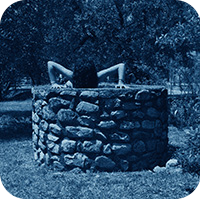The Nightmares of Illinois
Special note: this is a post about terrible things that have happened in Chicago and how they have been represented on film. Terrible things are happening in Chicago right now in broad daylight with not a serial killer in sight. If you live in Illinois and are concerned about or have witnessed human rights violations contact the Illinois Coalition for Immigrant and Refugee Rights (ICIRR) Family Support Network and Hotline at icirr.org or 855-435-7693. They run regular trainings and an alert text network. They could absolutely use your help.
Prefer to listen to this post? (It’s really me, not AI!)
Greetings, travelers! I hope you’re ready for another itinerary of place-based frights. Today we’re heading to the land that made me in a segment called The Nightmares of Illinois.
Every state has examples of real depravity exhibited by real people. Illinois is of course not unique. But it is where I am from, which is all the qualification needed to be your tour guide. So let’s get walkin’!
If you wanted to rank states by some metric of horror you could look at total serial killings. California leads the pack by a mile, followed by New York, Texas and Florida. Which is exactly what you’d expect. These are our four most populous states. But there’s something about serial killers from the American Midwest that captures the public imagination — and serves as inspiration for movies — in a way that other regions do not. For example, some of the most classic cinematic horror of the 20th century comes from the gruesome exploits of the grave-robbing skin-wearing murderer Ed Gein. Psycho, The Texas Chainsaw Massacre, The Silence of the Lambs — all from Gein, at least in part. And then there’s Jeffrey Dahmer, Milwwaukee’s most infamous cannibal predator. But that’s up in Wisconsin. Let’s travel about 89 miles south.
Chicago may be the origin for the idea of a serial killer. Or at least the earliest documented archetype of the behavior of what we’d later call a serial killer. Those of you who have read Erik Larson’s The Devil in The White City will know H. H. Holmes, pseudonym of a man who never met a category of crime he did not undertake: fraud, forgery, bigamy, horse thievery, and of course murder. Lots of murder. He confessed to killing 27 people — many of which have been disproven, but others are likely to which he did not confess. Part of the Holmes’ notoriety comes from his “Murder Castle”, a building on the south side of Chicago used to house visitors for the World’s Columbian Exposition held there in 1893. Contemporary journalists reported that Holmes asphyxiated his victims with gas lines, suffocated them in sealed vaults, and tortured them with various medical experiments. Many of these methods seem questionable based on modern research which says as much about journalistic sensationalism and the public’s fascination with it as it does about Holmes’ pathological inability to tell the truth. But H. H. Holmes was a sadistic killer — that much is indisputable. He was eventually caught, tried, and executed. In a possibly poetic ending his death by hanging did not come from a broken neck but rather slow, twitching asphyxiation after dangling from the gallows for twenty minutes.
Now, my tourists, if you were a visitor to the Columbian Exposition at this time and you craved the best encased meats Chicago could provide you would have headed 12 miles north to find Adolph Luetgert, the “sausage king of Chicago” and his factory. Hope you got a nice brat during the time of the Expo because in 1897 Luetgert was convicted of killing his wife and dissolving her in one of his sausage vats filled with lye. Rumors abounded that he ground up what remained as sausage and sold her off. This was not true, though it did demonstrably depress sausage sales in Chicago for some time. (Sidenote: remember that scene in Ferris Bueller’s Day Off where he claims to be Abe Froman, Sausage King of Chicago? No relation.)
Mail-order catalogs were all the rage at this time, having been invented by Montgomery Ward in Chicago in 1872 followed soon by Spiegel and Sears & Roebuck. This may have been the inspiration for the mail-order murders of the first female serial killer of our journey, Belle Gunness — known as Hell’s Belle in the press. Belle, a former butcher, collected her victims by placing marriage ads in Chicago newspapers. Interested suitors would be lured to her farm across the border in Indiana. And they would never return. Belle seemed mostly interested in the men’s belongings and wealth, which she would keep after dismembering them and burying them all around her property. Once discovered it was determined that due to the amount of body parts positive identification and even a total victim count would be impossible. It is thought Gunness died in a fire she ordered her farmhand to start in order to kill her children, though the headless corpse said to be hers was 5” shorter and 50 pounds lighter than Gunness. She never definitively reappeared though, despite rumors of escape.
Many murders have claimed to be the Crime of the Century (and most of these end up spawning numerous documentaries and films), but one of the first may be those committed by Nathan Leopold and Ricard Loeb, two students at the University of Chicago in 1924. Motivated by gross privilege and Nietzsche’s concept of Übermenschen, Leopold and Loeb devised a plan to commit what they considered the perfect crime. This ended up being the kidnapping of 14-year-old Bobby Franks as he walked home from school. TLDR; this was not the perfect crime. Leopold and Loeb murdered the child, attempted to disguise his identity with acid, and dumped him in a culvert. But they weren’t done. Part of their perfect crime included providing misdirection by sending a ransom note to Franks’ family. Through some remarkable forensics for the era a pair of eyeglasses found by the body was determined to be Leopold’s based on the uniqueness of its hinge mechanism. Also a typewriter used for the note was fished from a lagoon nearby and linked to the crime by analyzing its strike patterns. The boys confessed. At trial they were represented by super-lawyer Clarence Darrow of Scopes Monkey Trial fame who succeeded in obtaining 99 year sentences instead of execution. Jailhouse justice being what it is Loeb was murdered by a fellow inmate in 1936, purportedly after offering sex. The Chicago Daily News is said to have run the following headline which somehow did not win a Pulitzer: “Richard Loeb, despite his erudition, today ended his sentence with a proposition”. Leopold died a free man, paroled after 33 years. Boo.
Creepy messages written on mirrors in lipstick? Yeah, that’s Illinois too. Travelers, meet William Heirens, the “Lipstick Killer” of the suburbs. Starting in 1945 Heirens would break into women’s apartments, murder them apparently for the sheer thrill of it. He nom-de-guerre came about from a strangely-capitalized line scrawled on his second victim’s mirror: “For heAVens SAKe cAtch me BeFore I Kill More I cAnnot control MyselF.” This may be the first killer fulfilling the modern clinical definition of serial killer: someone pathologically driven to murder with no apparent motive. The tale of Heirens is mostly a legal one as he was eventually caught, confessed multiple times, and ultimately recanted. He died as Illinois’ longest-serving prisoner having spent 65 years in the clink, always petitioning for clemency or parole. Something I find humorous is that, having taken nearly every course available to inmates (and being the first Illinois prisoner to earn a four-year college degree) authorities forbade him from taking a course in celestial navigation — as if he was going to sail his way out of prison, Magellan-style.
A personal digression, if you will permit me. On the night of July 13, 1966 Richard Speck broke into a dormitory housing student nurses. He killed eight women that night, using only a knife. A ninth escaped by hiding under a bed. Also in July of 1966 my mother was a student nurse, though not with the same program and thankfully not involved in Speck’s atrocity. After the murders but before he was convicted, nurses throughout Chicago were assigned security guards to walk them from their hospitals to their cars or the subway. My mother befriended her guard who eventually invited her to a party he was throwing. She and her girlfriends showed up to find my father splayed out on a dining room table, presumably drunk but certainly having a good time. Thus began the relationship that would become a marriage and bring me into the world six years later. So … thanks Richard Speck? Still, if there’s a hell I hope you’re rotting in it. Music nerd sidenote: Cheap Trick’s first album contains a song about Speck called “The Ballad of TV Violence (I’m Not the Only Boy)”. And before you ask, yeah, that whole album is dark. Cheap Trick got lighter as time went on.
And now we arrive at our final destination, the clown-artist-monster John Wayne Gacy. Let’s make this a short visit as these crimes turn my stomach in a way that the others do not. And maybe this is because Gacy is a core childhood memory. I was old enough to follow the news by the time his crimes (and victims) were uncovered. And I was about the same age as most of them. Gacy killed at least 33 young men after raping and torturing them. 26 of these victims he buried in the crawlspace of his home just outside of Chicago. He also performed as a clown at various performances throughout the suburbs. So if clowns were not already terrifying to young me they became so when I learned this. John Wayne Gacy was convicted and eventually executed on May 9, 1994 — two days after I graduated from college. The only good to come from this devil: his crimes were the motivation behind the removal of a waiting period before law enforcement could begin the search for a missing child. Other states followed Illinois’ lead and would eventually link up efforts in a national network for locating missing children.
So that’s one particular kind of horror from Illinois. There are plenty of others that don’t involve murder. Interested travelers should take side trips to explore the sinking of the S.S. Eastland, the Iroquois Theatre fire, and The Great Chicago Fire. But here we turn briefly to movies. While Chicago ranks pretty high in the unenviable serial killer sweepstakes it ranks comparatively low for its population in the list of horror movie settings, #9 out of 50. (You’re telling me there are more horror movies set in New Jersey? Wait, that makes sense.)
Probably the most important horror movie set in Illinois is the original Halloween from 1978. Located in the fictional, presumably downstate town of Haddonfield, this film does a pretty good job of presenting semi-rural Illinois. I mean, minus the unstoppable killer. Most semi-rural towns in Illinois lack unstoppable killers. Except those discussed above. And even those were eventually stopped. Notably, Halloween was not filmed in Illinois — as the mountains you can see in the distance in some scenes will prove. This is the source of “the mountains of Illinois” TV trope that is well-documented.
Child’s Play from 1998 finds a Chicago detective pursuing a serial killer into a toy store. The killer is shot but not before transferring his soul via voodoo into a nearby doll. And thus was born a seven-film franchise, a TV series, and a reboot. The original film was fun. Brad Dourif as the voice of Chucky sells the whole conceit. But it doesn’t have a ton to do with Chicago except maybe the idea that there are enough serial killers running around that one of them might conceivably know voodoo and die in a toy store?
In my opinion the quintessential Illinois horror has to be Candyman from 1992. Shot in the real-life horror of Chicago’s despicable approach to public housing known as Cabrini-Green, it deftly weaves street-level verisimilitude, urban legend, and folklore. Come for the scenes of a Chicago near north side just before gentrification; stay for the exceptional performances of Tony Todd and Virginia Madsen.
The Relic from 1997 uses Chicago’s Field Museum of Natural History as the setting for what I will call anthropology horror. Basically this a creature-in-the-crate story like so many before it, but set almost entirely inside the museum. It’s an under-loved film in my opinion, featuring a decent monster and wonderful performances by Penelope Ann Miller, Tom Sizemore, and Linda Hunt. And the only reason it is set in Chicago is because New York’s American Museum of Natural History refused to let it be filmed there. Your loss, New York City!
Lastly, I must note Poltergeist III from 1988 not because it is a good movie — because it is not a good movie — but it is one of the few horror films I know of that takes place almost exclusively in a skyscraper anywhere. By the third film the idea of a house spirit was getting old, which I understand, but to this day I chuckle to think of someone proposing the idea of transplanting it to a luxe condo in the sky. Poltergeist III was filmed on location in the John Hancock building, using both its interiors and exterior scaffolding — real stunts — for effect.
Look, my travelers, there are plenty of other frights to explore in Illinois. If interested check out Something Wicked This Way Comes (1983), Henry: Portrait of a Serial Killer (1986) , Flatliners (1990) , The Unborn (2009) and The Rite (2011).
So that’s it for today. Hope you enjoyed this tour through the Land of Lincoln. Only 48 more states to go for this Terror Tourist. Thank you!
A full list of the movies mentioned above can be found at Letterboxd. Find out where to watch there.
The Terror Tourist is my occasional segment on the Heavy Leather Horror Show, a weekly podcast about all things horror out of Salem, Massachusetts. These segments are also available as an email newsletter. Sign up here, if interested. The segment begins at 16:30 in this episode:
Maybe Shark
Prefer to listen to this post? (It’s really me, not AI!)
Greetings, travelers! Grab a towel, maybe a snorkel too. This week we’re returning to a destination you may recall from last year’s itinerary called Doom Shanty — the horrors of the underwater world. But as seasoned visitors on this second trip we’re focusing on a specific threat. This death from below is almost as old as natural threats get. It was swimming in the waters of our planet before the land had trees. I speak, of course, of the diverse group of apex predators we call sharks. On this 50th anniversary of Jaws, a movie which changed movie-going and some people’s views of the ocean forever, let’s look at the evolution of sharks as the thing we fear in movies in a segment called Maybe Shark (doo doo doo-doo doo-doo).

Sharks have been around for almost half a billion years. As reference Homo sapiens — modern humans — have been around a short 300,000 years. Sharks are really good at what they do, which is almost constantly eating, sometimes reproducing, and mostly not being killed by other hungry things in the ocean. This is why they are sometimes called nature’s perfect creatures. And yet, to call sharks’ evolution perfect is to presume some sort of direction towards perfection. This is a mistake, as evolution has no direction — it’s just a series of random genetic fuck-ups that sometimes yield cool new ways of not dying. Sharks have been remarkably successful in adapting to changing conditions — everything from competition for food to global extinction events.
And what accounts for this success? Let’s drop below the waves in this sturdy cage and have a closer look. Sharks are fish, but importantly — and weirdly — they are mostly boneless. Their body structure is kept relatively rigid by tissues made of cartilage (what human ears and nose tips are made of). Being boneless makes sharks more buoyant. Lucky for us, even this cartilage fossilizes to some degree which is how we know anything at all about the most ancient sharks. The skin of a shark is composed of thousands of tiny teeth-like structures called dermal denticles, which is why it feels like sandpaper. Put another way, sharks are literally covered nose to tail in teeth.
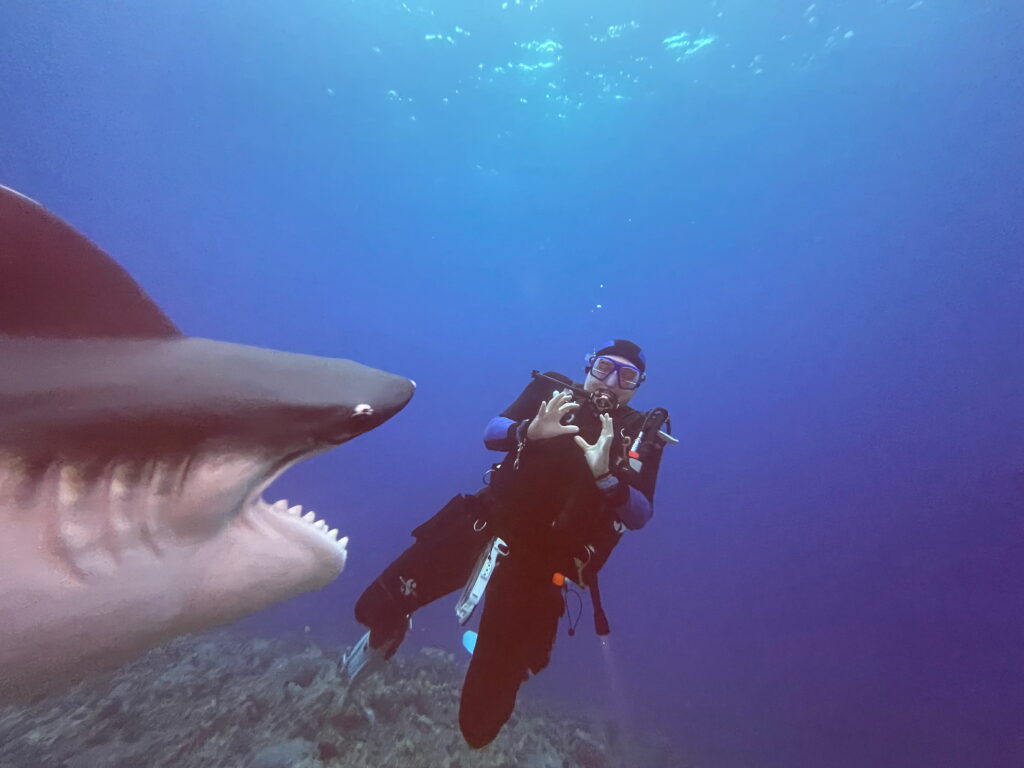
Sharks have phenomenal eyesight and an extraordinary sense of smell (they can detect odor molecules in dilutions as low as ten parts per billion). But sharks have a literal sixth sense too — they can detect electrical impulses in the water. Organs with the badass name of the Ampullae of Lorenzini form a network of mucus-filled pores that are both electroreceptors and magnetoreceptors. Why is this interesting? These ampullae are so sensitive that they can detect the electrical stimuli from the muscle contractions of potential prey. Too dark to see that tasty seal in the water column? No problem, sharks can feel their victims’ electrical presence. It’s almost magical. Having organic magnets is useful too. And this is why sharks can migrate ridiculously long routes around the planet without problem. The ampullae of Lorenzini are a built-in GPS system.
You’ve probably heard that sharks need to keep swimming or they will die. This is mostly true since, without lungs, it is the flow of oxygenated water through their gill plates that allows for respiration. But it isn’t completely true. Some bottom-dwellers, like angel and nurse sharks, have an extra organ than manually pulls water in over their gills so they can stay at rest for long periods of time. Which is why scuba divers will often encounter a shark just sitting there in a crevice. It’s momentarily alarming, sometimes terrifying, even if these species are completely harmless to humans.

So, yeah, sharks are adaptable. But it doesn’t end there. Have you heard of intrauterine cannibalism? Just what it says on the tin: shark sibling embryos that eat each other inside the uterus of their mother. (I must have missed the verse in the song Baby Shark on this.) How on earth is this a good thing? Turns out, sand tiger sharks only ever produce two pups — one from each uterus. This is far smaller than the normal litter of shark babies which for other species is at least a dozen. Baby sharks are small of course, which makes them prey, so the larger the litter size the better the chances some of them will survive. But with only two pups the sand tiger shark has the odds stacked against it. Unless the babies come out of the womb as seasoned killers already, that is! Not only do the cannibal embryos get a headstart learning the taste of blood from their unborn brothers and sisters, but statistically this is survival of the fittest — with only the best killers coming out into a world ready to climb up the predator chain quickly. There is video of intrauterine cannibalism. It is alien and disturbing and gross and completely awesome.
One note before we open this cage and soil our wetsuits. I mentioned above that one of the hallmarks of sharks’ longevity is that they are mostly not being killed by other hungry things in the ocean. They are certainly being killed by things on the ocean and that’s us, human beings. Mostly this is purely economic: humans kill 100 million sharks annually, mostly for the value of their fins, meat, skin, and liver oil. Many more are killed as bycatch when fishing for other things. But we’re also destroying their ecosystem as habitat is contaminated by toxic run-off, ripped to shreds by bottom trawling, or simply denuded of prey because ocean temperatures are rising past levels where fish can survive. More than a third of all shark species are facing extinction.
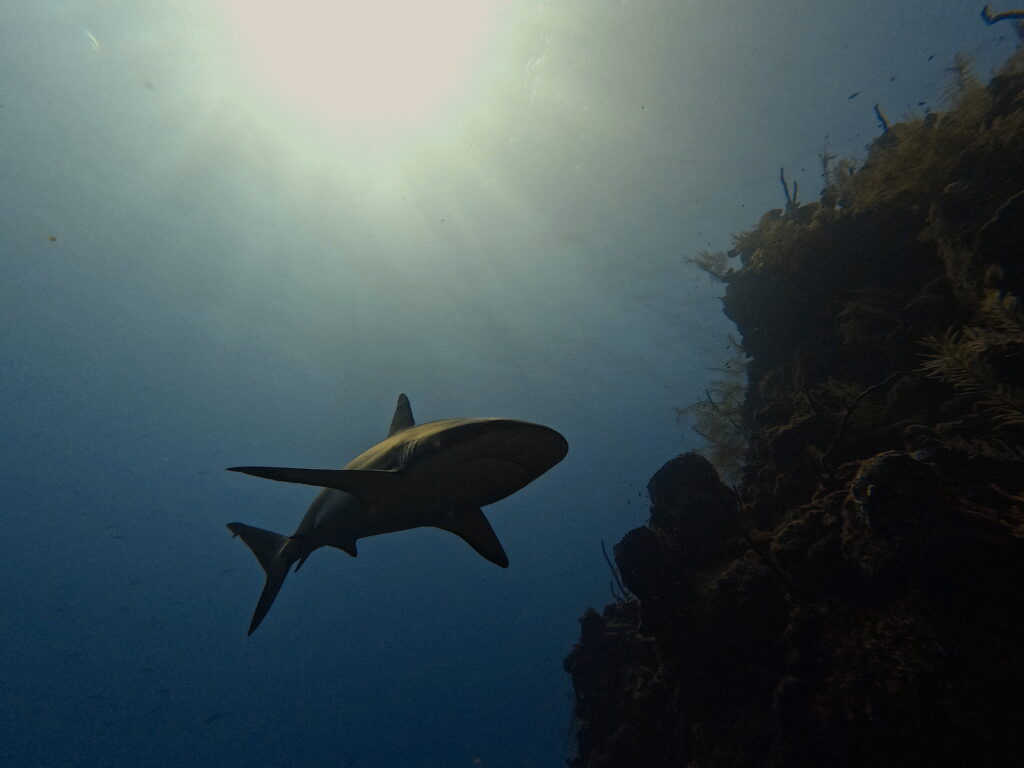
There’s another reason humans are a threat, though, and that has less to do with the actual killing of sharks and more with our attitudes towards them. The vilification of sharks is a full-blown industry, as the films we are about to discuss exemplify. With the exception of Pacific Islander cultures, the modern view of sharks has almost universally been one of fear and malevolence. We fear sharks thus we do not value them. This is a problem because an ocean without sharks is even scarier than an ocean with them. Without sharks, the global food web — a web that leads to your dinner plate and far beyond — would unravel. Entire ecosystems would collapse as prey species would overpopulate, herbivores would run amuck decimating coral reefs and seagrasses, making way for an explosion of algae all over everything. This would noticeably decrease oxygen production globally, making room for even more carbon dioxide in the atmosphere, hastening global warming. And we all know how that’s going. So, yeah, sharks are scary, but we need them if we want this third rock from the sun to continue to be habitable at all.
OK, the cage is unlocked. Find your dive buddy and let’s swim out slow and orderly. We’re gonna explore the history of sharks in horror movies.
Holy mackerel there are a lot of films about sharks! Far too many to watch — or want to watch. Lotta chum in these waters. But there are some useful ways of separating The Shark Cinematic Universe into categories. First, shark films are a good case study for discussing the differences between thrillers and horror movies. Often these two genres intermix. Sometimes thrillers have horrific elements. The best horror keeps you on the edge of your seat like a good thriller. But they are not the same. Horror’s engine is fear. A thriller runs on suspense. And this is why there are so many shark films that are not horror. For the most part Jaws from 1975 is the line demarcating the shift from shark thrillers to shark horror. (More specifically, that precise transitional moment was probably when young Alex Kintner gets torn apart on his raft.)
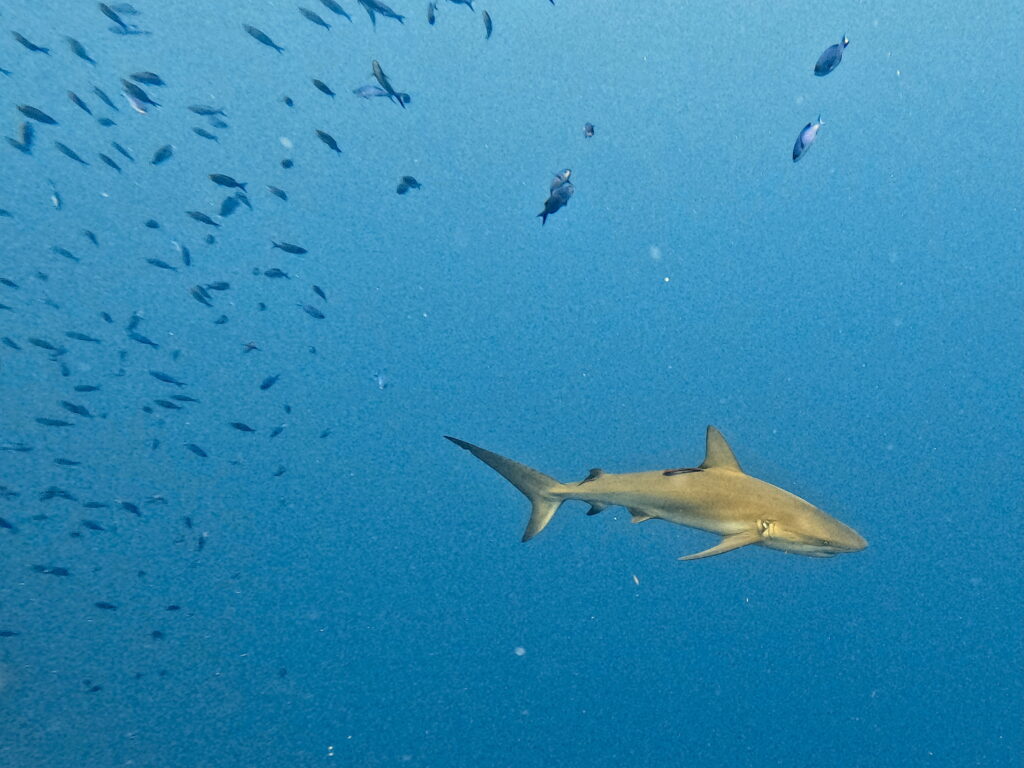
Pre-Jaws films with sharks were mostly adventure flicks. White Death (1936), filmed by Zane Grey as a fishing trip side-project, is basically a Western set on the ocean. The Sharkfighters (1956) is a fictionalized after-story of the sinking of the USS Indianapolis during WWII — the tale of shipwrecked sailors being ravaged en masse by sharks which you may recall that Quint famously recounts in Jaws. The Sharkfighters is notable for being one of the first films to use footage of real tiger sharks rather than puppets or dummies. Then there’s Shark (sometimes Shark!, 1969) starring Burt Reynolds and Silvia Pinal. Filmed in Mexico pretending to be Sudan it is mostly agreed that this film was an excuse for Reynolds and director Sam Fuller to party in beach towns. This movie has all the early tropes of ocean thrillers — unscrupulous treasure hunters, brave Westerners surrounded by caricatured locals, and the thought of sharks being in the water as all the tension needed. In a kind of snuff film-esque twist, it was claimed that a stunt diver was killed by a shark during filming. Life magazine did a photo spread of stills purportedly captured on film. After an investigation the magazine corrected itself, calling the story a hoax that involved a dead or drugged grey shark and “lots of ketchup”. But that didn’t stop the producers from marketing the film based on the supposed stuntman death. Maybe it was the success of this gruesome marketing that was the true harbinger of the turn towards horror just six years later.
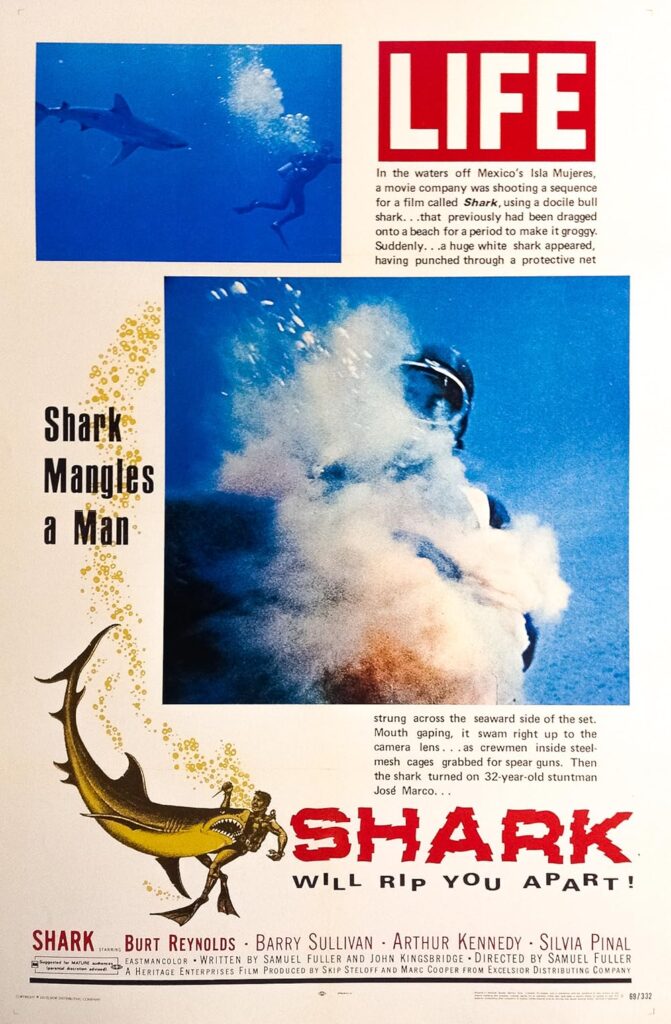
Do we really need to talk about Jaws? Who has not seen this movie? OK fine, scaredy-pants. But who has not felt the cultural impact of this movie? No one. Usually listed as a thriller — and I can see this argument — it is undeniable that the result of Jaws was pure fear. To this day there are people of a certain generation who will not swim in the ocean because of this single movie. Only the second feature film of young director Steven Spielberg, Jaws was a notoriously difficult movie to make well — from the instability of filming at sea to the mechanical shark named Bruce to Robert Shaw battling alcoholism on-set. But made well it was, so well that it created an entire new category of movie, one whose lines of ticket-seekers wrapped around movie theater blocks, effectively “busting” them. The blockbuster became the new Hollywood business model: the pursuit of high box office returns from heavily-advertised action and adventure films released during the summer. For our purposes what Jaws proved is that there clearly was a market for being scared by sharks.
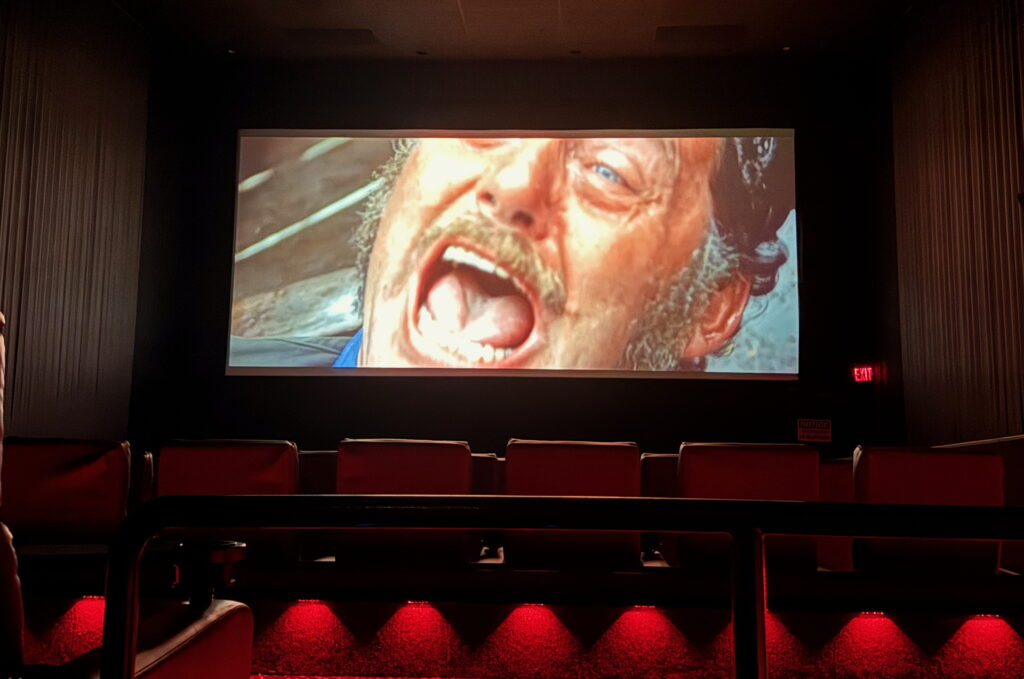
Sidenote: the main shark theme music — a could-not-be-simpler alternation of two notes one half-step apart — may be the most recognizable piece of music in the entire history of film. Composer John Williams described the theme as “grinding away at you, just as a shark would do, instinctual, relentless, unstoppable.”
You know what else is unstoppable? Film studios’ pursuit of money. After Jaws there was an absolute frenzy of shark movies looking to take a bite out of the market. Jaws itself had three sequels, the first of which was decent. The other two we shall not discuss. The 70s and 80s were awash with knock-off shark flicks: Mako: The Jaws of Death which was first on the bandwagon in 1976 and at least spices up the plot with a man who achieves some telepathic connection with sharks from a shaman’s medallion and Shark Kill, also from that year, which is just made-for-TV slop. Oh but then Mexico got in on the action releasing Tintorera (1977) — we’ll come back to this one, Cyclone (1978), and Bermuda: Cave of the Sharks (also in 1978).
Hang on, don’t forget the Italians, next in line (such as Italians know how to form a line — I can say this, as I am Italian). Spending exactly one month in theaters in 1981 before being sued into oblivion by Universal was Great White (also known as The Last Shark) starring Vic Morrow who would be decapitated by a helicopter stunt gone horribly wrong on the set of Twilight Zone: The Movie less than two years later. Courts would rule that Great White was exactly the same film as Jaws. Which may be, but I found it to be a great watch. None other than giallo maestro Lucio Fulci was a fan of the aforementioned Tintorera. He wasn’t a big enough fan to approve a zombie versus shark scene suggested by his producer for his film Zombi 2 (aka Zombie Flesh Eaters), but that didn’t stop it from being filmed by his special effects lead Giannetto De Rossi inside a large saltwater tank with a recently-fed and heavily-sedated shark. Eventually Fulci agreed to include the now-infamous (and ridiculous) sequence. But here’s the interesting part: a local Mexican diver and photographer named Ramón Bravo was hired to fill in for the stunt man as the underwater zombie fighting the actual shark. Ramón Bravo wrote the novel Tintorera upon which the movie was based! Full circle.
So that’s the immediate before and after Jaws. First, sharks as thriller plot sidepieces shot poorly without color correction (or using stock footage). Then Jaws. Then a whole bunch of not-great derivative films coming from the usual suspect countries. That’s only the beginning though. Things start getting really good again — or at the very least, more interesting — around the turn of the millennium. This is largely due to what I consider the second best shark horror film ever made, Deep Blue Sea. Directed by Renny Harlin and released in 1999 this film stars Thomas Jane, Saffron Burrows, Samuel L. Jackson, and LL Cool J. Which, c’mon, that’s one hell of a cast. The premise here is basically what if we made a killer shark movie more like a slasher film? You may be wondering, how would you even do that? First, genetically enhance your sharks in a secret research facility. Make ‘em smarter and more cunning. Then partially flood the facility so the sharks can move about its corridors, but humans can still run and move through the same corridors. Voila! Slasher shark film! You may think that there was nothing redeeming about James Cameron’s Titanic from 1997, but you would be wrong, as the sets for Deep Blue Sea were constructed atop the massive water tanks that had been built in Baja California for Titanic. Its heart — or at least its massive tanks — did go on. Deep Blue Sea is a fun film, a scary film, and a pretty novel one at that. The baddies here aren’t the sharks so much as the people who modified and experimented on them. Sharks as antagonist but not as villain; sharks as bullet but not the gun. This is a tonal shift we will see again. More than anything Deep Blue Sea jumpstarted shark films again, yielding a whole lotta awful — basically the second wave of sharksploitation — interspersed with some pearls.
It took about a decade to really get going, but honestly the sheer amount and at least conceptual creativity of the shark films about to be unleashed on the public is impressive. Let’s run down a few:
- In Sharktopus (2010) there’s only one reason the US Navy would engineer a half-shark, half-octopus creature for combat. It’s so that we could look back on the relative sanity of this hybrid once the sequels were released. Please enjoy Sharktopus vs. Whalewolf and Sharktopus vs. Pteracuda.
- The premise of Sharknado (2013) starts with a tornado that scoops up and throws ravenous sharks all over town. And that’s the least ridiculous of the premises of the five Sharknado films which, like all horror series that have run their course, eventually goes to outer space.
- Ghost Shark (2013) solves a problem with sharks, namely that you can only be attacked by one if you are in a large body of water. This movie is hilarious. The slightest amount of water, even just a puddle, can unleash Ghost Shark!
- Please read this movie title a few times: Sharkansas Women’s Prison Massacre (2015). This film delivers everything (except an enjoyable experience): a fracking mishap, giant prehistoric sharks, female prisoners on a work detail in a swamp, and Traci Lords playing a detective for some reason.
- As a fan of Christmas horror, I watched Santa Jaws (2018). My strong advice to you, travelers, is not to watch this. The gag of a Santa hat being worn atop a shark dorsal fin slicing through the water is mildly humorous precisely one time.
- Midwest represent! Sharks of the Corn (2021) is exactly what it sounds like — and should not be.
- Nothing stirs a sense of patriotism like Americans fighting unkillable sharks launched to the moon by the Soviets years ago. Please salute Shark Side of the Moon (2022).
As you can see from these films sharks have become bolt-on accoutrements to almost the entire range of horror tropes and sub-genres. Monster movies, ghost flicks, religious horror, space frights, and then just straight up replacement of killers from previous films with … sharks. Is this lazy? Sure. Is it fun? Usually! In 75 years sharks have gone from representing the threat of the unknown, to evil killers, to placeholders for whatever situation needs more menace. We said it before at the beginning of this journey, but it probably bears repeating: sharks have been around forever because they are almost infinitely adaptable.
Travelers, I know what you are thinking: there are so many shark horror films — and most of them are terrifically bad. Can’t you please provide a smaller map of the best destinations? Sure, can do.
Open Water (2003) — Based on the true story of two scuba divers left behind when their dive operator doesn’t perform a proper headcount, the horror here is more the terror of being alone in the sea. Only later do sharks do what sharks do best. As for what really happened to these divers we will never know. Maybe they died well before any sharks showed up. Maybe there were never any sharks at all. All we do know is that those divers did not live.
The Reef (2010) — Based super loosely on a true story where two people were killed by sharks, this film uses real sharks superbly edited to tell the tale of a group of folks trapped on a capsized yacht. A very similar premise to Open Water. The characters here just have the hull of a boat to cling to instead of bobbing around in the waves. The result is the same ultimately.
Bait (2012) — Australians know how to do sharks (as you might remember from the recent grotch Dangerous Animals). Bait takes place almost entirely inside a flooded grocery store next to a beach. If you liked the everyday confines of the movie The Mist and sharks in corridors like Deep Blue Sea you’ll love this.
The Shallows (2016) — Starring Blake Lively … and a shark. And that’s really it. What’s incredible about this film is how a single person trapped on a rock with a Great White shark circling around makes for a compelling film. But it very much does.
47 Meters Down (2017) — Stuck in a cage at the very limits of recreational diving (and nitrogen narcosis) this is The Shallows with one extra character and a giant twist at the end. Obviously there are sharks, but there’s also the overriding dread of an ever-diminishing air supply to quicken the pulse.
Under Paris (2024) — I found this more compelling than the Olympics opening ceremony it meant to prefigure (which also took place on the Seine). Under Paris is actually a really fun movie with flooded catacombs, mutant sharks, and a triathlon stand-in for the Olympics that becomes a chomping smorgasbord.
There are so many others. You could watch one shark horror film every week for a year and probably not run out. I do not advise doing this.
Let’s conclude this week’s journey with a quote from a recent New Yorker piece on what we really have to fear about sharks:
There is no such thing as shark-infested waters, in the same way that there is no such thing as a child-infested school. You cannot infest your own home. Fear is, of course, a great good. It can be a form of wisdom. But if we could reorient the sentiment—and direct it, for instance, toward those humans whose vested interests lie in persuading us to acquiesce in the living world’s destruction—we would fare better. Beware an ExxonMobil-infested State Department; beware a fossil-fuel-infested politics. These are dark times, and there are many things to fear. But none of them are found swimming under a vast sky as the waters around us warm and empty.
That’s it, my waterlogged travel-mates. You can surface now, but carefully. Stay vigilant out there, but I really wouldn’t worry about sharks. Until next time, I am your faithful tour guide.
A full list of the movies mentioned above can be found at Letterboxd. Find out where to watch there.
The Terror Tourist is my occasional segment on the Heavy Leather Horror Show, a weekly podcast about all things horror out of Salem, Massachusetts. These segments are also available as an email newsletter. Sign up here, if interested. The segment begins at 22:40 in this episode:
Land of the Shtriga
Prefer to listen to this post? (It’s really me, not AI!)
It’s been a while since our journey took us to an actual place, like a country. Let’s get back to our roots here.
What makes something a horror representative of a nation? It can’t be merely that the country is used as a shooting location. If it were there would be hundreds of films we could consider Hungarian, Croatian, or Slovakian horror. Sometimes I think every third person on the street in Budapest is a film fixer. But that’s not how it works. To be a national horror generally requires either of these two characteristics (and the best have both): 1) majority cast and crew from the country — bonus if it is the director, writer, and lead actors and/or especially 2) the story centers on regionally- or nationally-specific fears, concerns, and/or cultural narratives. Very few filmmakers set out to make a national horror, though some do — looking at you A Serbian Film. But many use a region’s cultural memory of folklore or legend to make something unique.
So where are we going? If you’re coming from the USA, cross the Atlantic, and head to southern Europe. You can grab an espresso in Italy, but keep going. Cross the Adriatic, wave to the pretty dogs on the Dalmatian coast but do not stop — move southeasterly. Hit Greece? Too far. Back up. Our destination today is the incredible country of Albania in an installment called Land of the Shtriga.
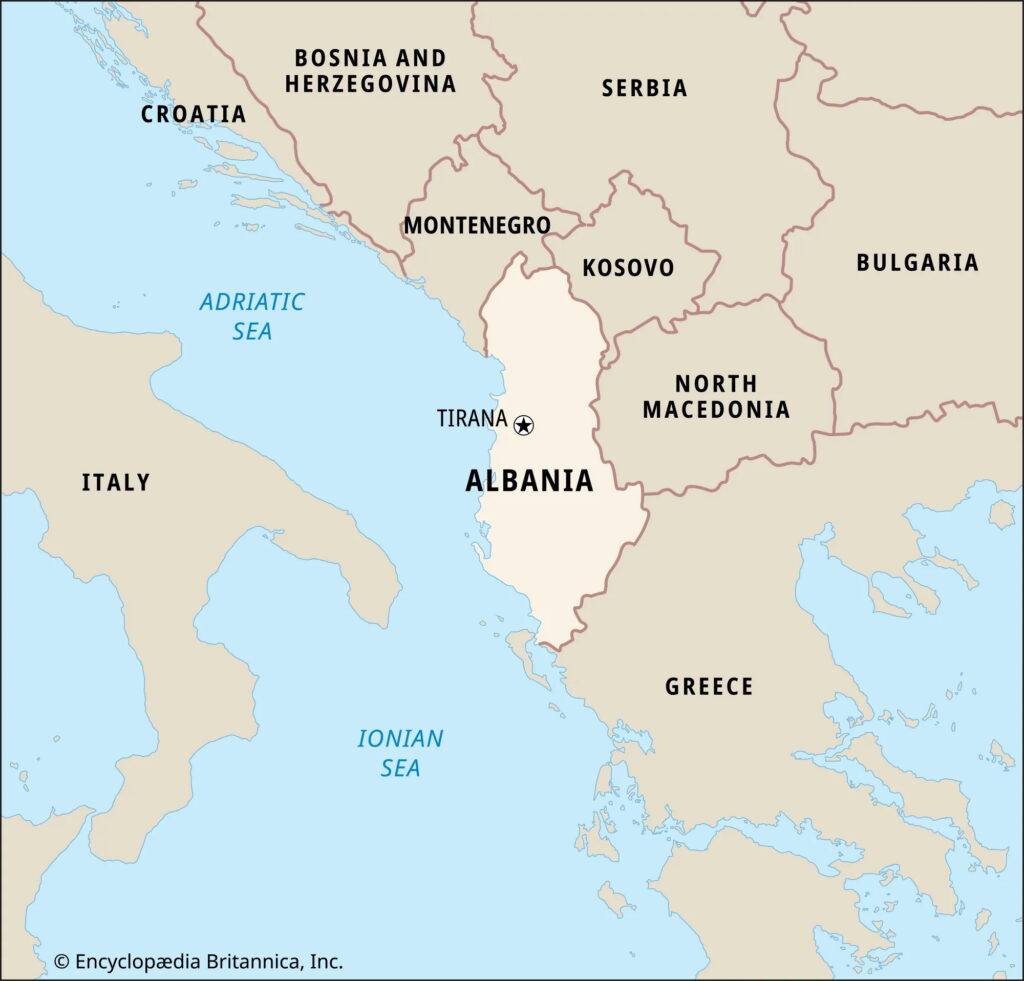
First a very brief history of this land. As noted, my traveling compatriots, if you jump off the very heel of the boot of Italy right where the Adriatic Sea becomes the Ionian Sea you’ll hit Albania. Situated directly northwest of Greece and west of Macedonia, the tribal peoples of this land — known as Illyrians — were successively ruled by Greece, Alexander the Great, and eventually the Roman Empire. It was the establishment of independent Eastern and Western Roman Empires in 396 AD and even more so the schism between the western and eastern Catholic churches in the 11th century that created the remarkable diversity of architecture, religion, and peoples that populate the land to this day. Throughout the late medieval period the various principalities coalesced into something resembling an Albanian identity.
That is until the fall of Constantinople in 1453. The Eastern Roman Empire was no more as Ottoman Turkish forces pushed into what is modern day Albania by the end of the 15th century. Thousands of Christian Albanians fled to southern Italy during this period (including the ancestors of my paternal great-grandparents). Of note, this period is noted for national hero General Skanderberg who successfully defeated major Ottoman armies including those of Sultan Mehmed II, in the process uniting many of the principalities. If this sounds familiar to horror history fans your intuition is correct: Skanderberg was a contemporary of and very similar to Vlad Dracul III of Wallachia, known as Vlad the Impaler, our Count Dracula. He too fought against the Ottoman armies, holding them off for a time. Like Vlad, Skanderberg only delayed the conquest — a fact many historians credit with ultimately halting the expansion of the Ottoman empire at the Balkans and giving Italy enough time to mount an effective defense of Western Europe. The Albanian peoples continued to develop a united identity, but it was a unification under rule from Istanbul and amidst large-scale Islamization of its culture.
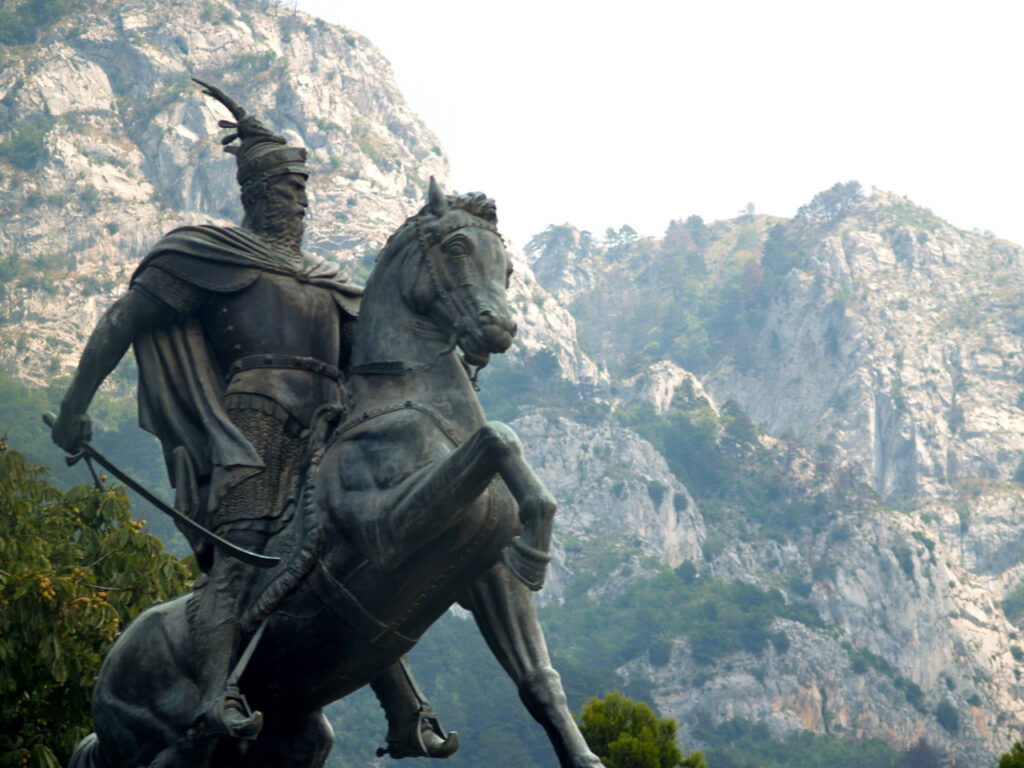
All of this to say to you, my tourists, that like many countries bordering the Mediterranean, Albania is a swirling mixture of peoples and beliefs stirred by a legacy of suffering as victims of imperial forces criss-crossing the Sea. To Western Europe Albania was an almost mythical place, sitting at the edge of what they considered enlightened civilization. Fans of Shakespeare will remember that his comedy Twelfth Night takes place in Illyria, a fictional setting (but obviously based on Albania) chosen for its exoticism and remoteness. This conception of Albania as a liminal place between worlds carries through in the Western imagination almost to the present day. A great setting for a horror movie, no?
World War I spelled the end of the Ottoman Empire and saw the birth of an independent Albanian state, a republic which lasted until invasions both by Mussolini and then, after his not-soon-enough encounter with a lamppost, by Nazi forces. In 1944 anti-Nazi partisans which included future leader Enver Hoxha, successfully liberated the nation leading to four decades of Communist dictatorship aligned alternately with the Soviet Union and Maoist China. With the fall of the Berlin Wall and eventually the Soviet Union, communist rule in Albanian also ceased leading to rapid Westernization in the 90s. Albania today is a multi-party republic, a member of NATO, and a candidate for EU membership.
Two special notes before we arrive at our destinations.
First, the Albanian national flag. Listeners, search for this magnificence right now so that you too may appreciate it. The Albanian flag may be my favorite national flag of all 195. It depicts a two-headed eagle, talons outstretched, in all black set against a blood red background. It’s clearly a bird, but you’d be forgiven for believing it more fantastic than that, like a Hydra or Cerberus. No staid symbolism, no echos of other countries’ flags, just a badass beast you do not want to mess with. In my opinion if you can’t tell if you’re looking at a biker gang tattoo or a national emblem you know a flag design is going to at least inspire awe.

Next we need to talk about the Gjakmarrja, the Albanian blood feud. The Gjakmarrja, based on a larger social code called the Kanun, is the social requirement to exact revenge usually via murder to defend one’s honor. The blood debts owed to an aggrieved family can extend generations if not paid. This code of socially-sanctioned revenge has been kept alive for centuries by tribal elders exclusively via oral transmission. As recently as 2018 police records noted 704 families affected by blood feuds. Fertile, blood-soaked ground for horror movies, no?
So let us now travel from blood feuds to actual blood — at least the cinematic kind. The truth is, Albanian horror as a genre is not even a decade old. While there are other Balkan and Kosovar examples of horror filmmaking, you can count the number of Albania-specific horror films on one hand, indeed one hand missing two fingers.
Bloodlands from 2017 is often considered the first Albanian horror film, though this was part of its own marketing effort so we’d need an actual film scholar to make a definitive call. The story here centers on the family of a butcher named Skender living on the edge of poverty in a clearly post-communist quasi-rural town. We are shown the actual butchering of a lamb in all its gory detail and you just know this is the most overt kind of foreshadowing. Skender’s shop is beset by grimy forest-dwelling people who scavenge offal from the trash until he runs them off. Meanwhile Skender sees a man on the street who he could swear died many years ago. Enter the shtriga, an Albanian witch (related, at least etymologically, to the strega the Italian witch). Turns out the shtriga leads a group of vagabond, possibly undead cannibals who eventually stumble upon Skender’s son in the forest. Skender goes looking for his boy and eventually blasts his captor with a shotgun. Thus begins the blood feud. Skender is abducted and gruesomely butchered (and eaten) exactly as the lamb he cut up days earlier. With no body to bury the family sets off to exact revenge for this revenge, leading ultimately to a confrontation with the shtriga. This isn’t a great movie, but it is absolutely horrific and totally steeped in very Albanian lore. The irony is that Bloodlands was written and directed by Steven Kastrissios, an Australian.
If postwar Albanian history is your thing, you’ll get it in spades with The Invocation of Enver Simaku from 2018. This film begins in 1997 during the tumultuous civil rioting — some call it a war — precipitated by the financial idiocy of the immediate post-Soviet government. (Like so many countries freshly out from under the Iron Curtain, Albania suffered from national monetary policies based on pyramid schemes and formerly nationalized industries being gobbled up by mafia-like oligarchs.) The narrator/documentarian, Julien, at the center of this camcorder-style film positions himself in the midst of these riots where his partner Angela is murdered, one of at least 2000 dead when it was all over. Twenty years later he returns to try to find out exactly how and why she died. What’s key here is the flourishing (or re-flourishing) of ancient folk beliefs after their official ban during the decades of Communist rule — Albania being the world’s first (maybe only) constitutionally atheist country during the Hoxha regime. Well the old ways flood back and Julien soon enough finds out that his partner was murdered by the brothers of Enver Simaku, a man in a 30 year-long coma who possessed by an Albanian demon known as the Kukuth There are no great kills, no jump scares, and only some passably creepy scenes. But The Invocation of Enver Simaku is a unique mixture of political history and supernatural folklore, neither of which is much known by audiences outside of the immediate region. This is also not a great film — just the mixture of languages is off-putting (English, Albanian, Italian, and Spanish — some but not all of which are subtitled), but its ambition is laudable and if you like slow-building drama that only flirts with being a true horror movie this is definitely for you.
Blades in the Darkness from 2022 takes the legacy of communist rule very literally. The whole thing takes place and was filmed in a disused Hoxha-era underground bunker. Like Enver Simaku this film also begins amidst the riots of 1997 where a young boy, Matia, seeks shelter in the abandoned bunker. He is scarred by a run-in with barbed wire and then bricked into the bunker by a crazy unregenerate communist named The Commander and his wife. Jump to 2022. The bunker is being visited by a group of investors — the term here being used extremely casually — interested in turning it into a nightclub and restaurant. There, while dealing with drug dealers owed a debt by one of the investors, they encounter Matia, horribly disfigured, all grown up, and presumably deeply scarred by a communist propaganda 8mm film he’s been forced to watch on repeat in the bunker for the past 25 years. He looks sorta like the Predator alien with long knives attached to the ends of his arms. At this point we have a slasher film as Matia rampages through the bunker, especially pissed off when the projector breaks and sets the corpse of one of his initial captors aflame. A corpse, it should be noted, that he has seated in a chair and which he animates like a marionette. Just sayin’ that 25 years without sunlight is not good for one’s mental health. Blades in the Darkness is maybe the most typical horror film in this lot, though with so many references to the last 50 years of Albanian history it’s easy to see why it could be interesting beyond the gore. For example, adult Matia is listed in the credits as “The Eagle” and his knife-hands do kinda resemble talons so let’s remember that dope Albanian flag. It makes an appearance in the fiery climax and Matia eventually bleeds out on the pavement in a way that exactly mirrors the flag eagle’s feathers. So obviously the filmmakers here are trying to say something about the country. I’m just not sure what exactly. Technical note: like most films that I can only find dubbed I probably would have enjoyed this more if it had been subtitled. Awesome movie poster though. And apparently there is a sequel to this the connection being that it … also employs blades? Hard to tell.
Then there’s Vlog#13 from 2023. iMDB says: “This film follows vloggers exploring Albanian legends, potentially incorporating horror elements based on folklore.” Now the word ‘potentially’ is the tell here: this film does not exist — or if it ever did it was a one-off showing somewhere that’s not recorded anywhere online. This film is not available to stream or rent anywhere and does not exist on any of the half dozen trackers I checked. Travelers if you have seen this movie or any of the vlogs 1 through 12, please call our hotline immediately. It sounds like a perfect anthology of Albanian frights.
So that’s all there is, really, my tourists. Albanian horror is a newborn baby. I do believe I watched everything I could that exists in this sub-genre. But this newborn has some wonderfully rich genealogy. The history of this often-overlooked land is full of subject matter that lends itself perfectly to horror. I say, if Romania can have a horror legacy (even if it was invented by a British Victorian) then so can Albania. Let’s make this happen!
Until next time, I am your faithful tour guide. Thank you for joining us on this journey.
A full list of the movies mentioned above can be found at Letterboxd. Find out where to watch there.
The Terror Tourist is my occasional segment on the Heavy Leather Horror Show, a weekly podcast about all things horror out of Salem, Massachusetts. These segments are also available as an email newsletter. Sign up here, if interested. The segment begins at 17:15 in this episode:
1972
Prefer to listen to this post?
My sightseeing companions, today’s journey takes us to a single year in film history.
It’s the year The Joy of Sex was published. The year Nixon recorded himself chatting about hiring thieves to break into an office complex. The year an American used the Sicilian Defense to open a chess game where he would defeat a Russian for the World Championship at the height of the Cold War. It was the last time humans walked on the surface of the moon. And it witnessed the last time two leap seconds were added to clocks, making it the longest year in recorded history. This is the year 1972.
Why ’72? Partially I was curious what filled the void of lesbian vampire movies after their remarkable run in 1971. But mostly it is because this is year of my birth, what some would call the ultimate horror. I wondered: what world — and what fears, specifically — were reflected in the cinema of 1972?
So what was happening? What was scaring the world in 1972? The Vietnam War continued to mire the United States even amidst a painfully slow troop withdrawal. Massacres and atrocities abounded as the public were increasingly horrified by the photojournalism coming from the front lines, including the agonizing photo of the little girl Phan Thi Kim Phuc running naked down a road after a napalm attack.
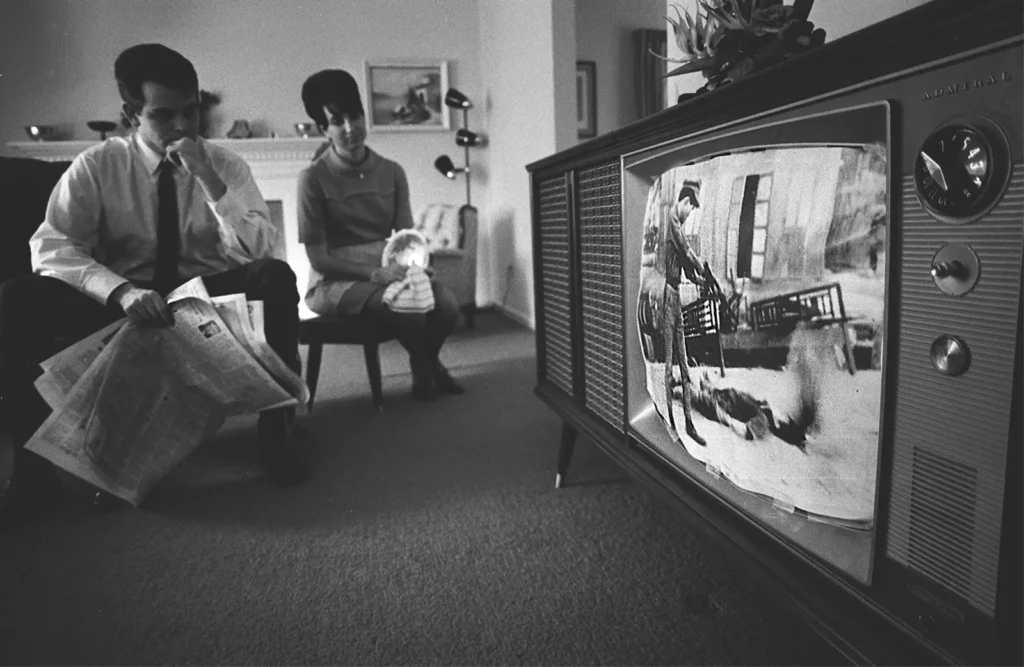
Richard Nixon, the embodiment of what he called the “silent majority” backlash against the counterculture of the 1960s, was riding high with a first-ever visit to China and the beginning of the SALT treaties in Moscow. But in June of ’72 his goons broke into the Democratic National Committee HQ, beginning the scandal that would lead to his resignation and, more importantly, the slow, ceaseless erosion of public trust in elected officials.

In Munich a terrorist attack on the Israeli Olympics team, killing 11 athletes, stunned the world. The long-debated Equal Rights Amendment which guaranteed the same rights regardless of sex finally passed Congress, but would never achieve the ratification by 38 states needed. We’re still waiting.
Meanwhile the world was slowly awakening to the horrors modern life and industrialization were inflicting on the environment. The UN Stockholm Conference was the first to recognize environment protection as a global priority. In response to high-profile events like the Cuyahoga River spontaneously igniting and chemical levels in Lake Erie high enough to develop photographic film, the US passed the Clean Water Act.

And of course the Cold War still raged, despite halting efforts at detente. At least since the Cuban Missile Crisis a decade earlier the world had lived under the ever-present threat and existential anxiety of total planetary annihilation.
Unsurprisingly, the 1970s were a golden age for frights on the big screen. The VCR era was about a decade away, so if you wanted to be scared by the latest movies had to sit your butt in a theater. And often those theaters were dingey, raucous grindhouses showing double and triple features of just about anything a filmmaker could produce.
1972 witnessed the height of giallo, what we thought was the end of Herschell Gordon Lewis, the debut of Wes Craven, the birth of blaxploitation, and a fulsome shift from the gothic frights of the 1960s to a much grittier, visceral, bloody mess-type horror. Let’s have a stroll through a few films I’ve seen that characterize this year.
Sidenote: There’s almost no through-line in the films I’m about to tell you about, except possibly the way they were processed and colorized. Rich warm colors, hazy edges — what has been called “the tattered comfort of a worn family leather couch”.
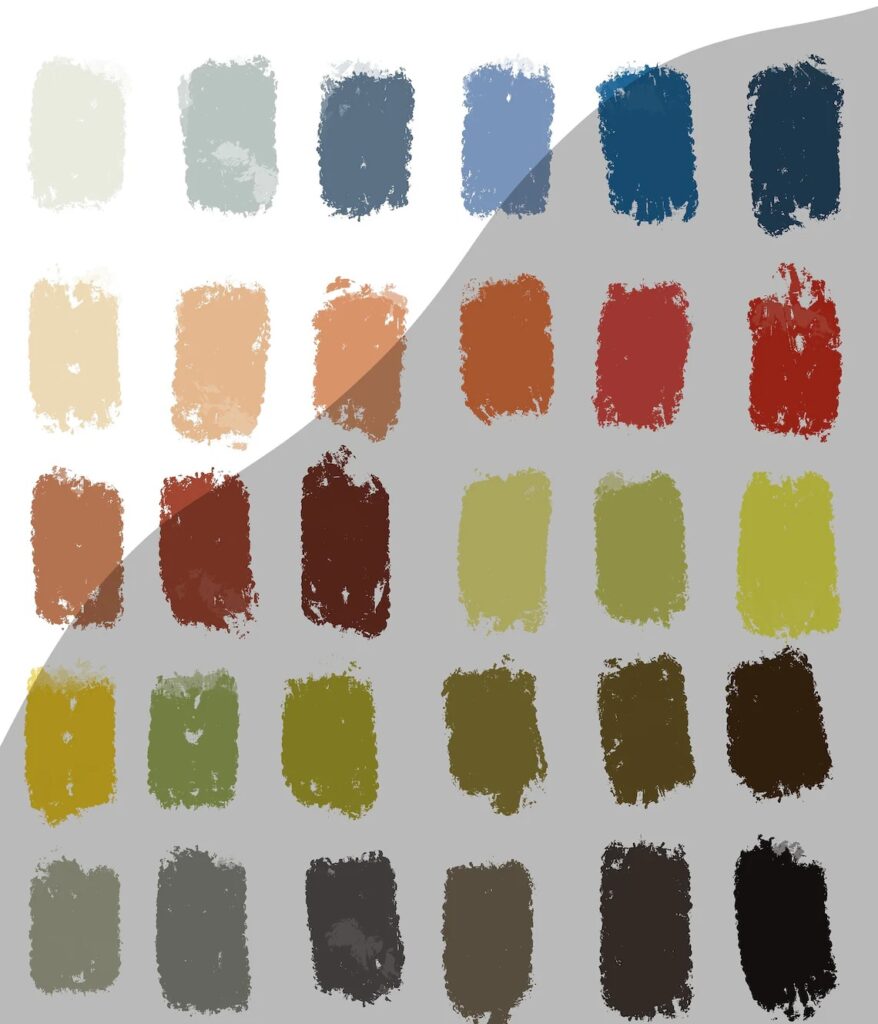
Of course this is not a comprehensive list of what is popularly considered the Best of 1972. Just some stops on my own personal itinerary I’d like to tell you about.
1972 was the year that Lucio Fulci went full-gore with Non si sevizia un paperino, known in English as Don’t Torture a Duckling. Fulci here takes on folk superstition in my family’s dusty ancestral homeland of Basilicata. But the witchcraft here is a red herring. It’s a corrupt, sexually perverse Catholicism at the root of this horror. Catholicism as the bogeyman is a theme that would be well-explored later in the 70s. The slashing killer as the punisher of sinful behavior replaces god in many ways. And Catholic ritual itself becomes the setting for masterpieces like The Exorcist in 1973 and The Omen in 1976. Fulci didn’t start the anti-Catholic theme in horror but he certainly propelled it forward in Don’t Torture a Duckling.
Speaking of replacing deities, 1972 also gave us the first cinematic treatment of the venerable comic Tales from the Crypt (full movie at link below). Here the cryptkeeper is a sort of ghoul of Christmas past (literally in the case of the first segment). The crypt that five tourists have stumbled into turns out to be a waiting room before being sent to hell for their misdeeds. It’s five separate tales unfold about people being horrible and getting their comeuppance: murder of a spouse, infidelity, bullying a neighbor to suicide, neglecting nursing home patients, and the like. This is a much better movie than I thought it would be — and true to the kind of shock and final-panel climax so key to the comic books.
Tourists, you may think rape-revenge films started in 1978 with I Spit on Your Grave, but you’ll have to back up six years to Wes Craven’s first film The Last House On The Left. This film, which would launch the career of producer Sean Cunningham of Friday the 13th fame, tells the story of a pair of friends heading to a concert who encounter a group of escaped inmates. There’s rape, torture, and murder. It’s not easy to watch. But the innovation — if it can be called that — is what happens when the group heads to the last house on the left, home of one of the victims. There they encounter her parents who after initially offering hospitality come to understand they are hosting murderers. Thus begins the revenge portion of the film, really only the very last act — but it is uncharacteristically gory (a bitten-off penis, an electrocution, throat-slitting, chainsaws) for the time. If you remember the foundational moment driving Freddy Kruger in A Nightmare on Elm Street 12 years later — parents hell-bent on revenge who murder him grotesquely — you can see Craven beginning that exploration here.
Were American audiences numbed to onscreen violence and images of depravity coming nightly from Vietnam? Possibly, though contemporary reports of audience reactions to Last House On The Left certainly mention traumatized audiences and even theaters which would not show the film. A more likely explanation comes from Craven himself who felt that popular films of the era, such as Westerns, tended to glamorize violence — a misleading representation of death in the wake of the Vietnam War.
For something completely different we have Sisters, early Brian DePalma, starring a truly phenomenal Margot Kidder. While it is at once an obvious homage to Alfred Hitchcock thrillers, complete with inventive camera angles and split screens, it is also a remarkably forward-thinking commentary on women’s liberation and autonomy. You’ll have to trust me on that, because I can only give a partial plot here so as not to ruin the twist I certainly did not see coming. Kidder plays Danielle, an aspiring actress living in Staten Island, who murders a one-night-stand in her apartment after she fails to take a mysterious red pill. A neighbor named Grace witnesses the man’s dying moments through her rear window and sets off to determine what happened. Suffice to say that there is a twin in this mix, a sister, but it probably is not in the way you might imagine. I’ll note only the film’s marketing tagline: “What the Devil hath joined together let no man cut asunder!” This movie is what happens when you let men literally shape a woman’s body. Roe v. Wade was only one year away.
Tourists, we’re at the end of a short jaunt that will reward much lengthier journeys, should you desire. Want an extended itinerary? Here are a few more films that defined 1972:
- The Night Stalker
- What Have You Done to Solange?
- Frogs
- Images
- Asylum
- Your Vice Is a Locked Room and Only I Have the Key
- Horror Express
- Grave of the Vampire
- Night of the Full Dark Moon
- Blacula
- Private Parts
- All The Colors Of The Dark
- The Red Queen Kills Seven Times
- Tombs of the Blind Dead
1972 was no conspicuous demarcation in horror filmmaking — you might give that description to 1973 or 1978 — but in spending some time here it’s clear that, as ever, horror is a particularly insightful lens through which to perceive history.
That’s it for this week, travelers. Maybe we’ll tackle another year at some point. If you have a favorite year, please call our hotline. Until then, I am ever your faithful Terror Tour Guide.
A full list of the movies mentioned above can be found at Letterboxd. Find out where to watch there.
The Terror Tourist is my occasional segment on the Heavy Leather Horror Show, a weekly podcast about all things horror out of Salem, Massachusetts. These segments are also available as an email newsletter. Sign up here, if interested. Here’s the episode containing “1972”:
Descent to Xibalba
Prefer to listen to this post?
Travelers, today we journey to Middle America. No, not the middle America of small towns, wingnut politics, and climate denialism (though that’s a frightful destination we really should visit someday). I refer here to the original middle America which historians refer to as Mesoamerica, the collection of cultures inhabiting the southernmost part of North America, the Yucatan peninsula, and the Pacific coast of Central America from almost 2000 BCE up until Spanish greed fucked it all up in 1519. The descendants of the these ancient cultures number around 7 million today in a mostly Westernized Mexico and Central America lucky to have them.

Why go here, you ask? Because the cultures of Mesoamerica were absolutely rad, that’s why. You like chocolate? Of course you do. Thank the Mayan civilization. Hey you texting on your phone and not paying attention to this tour, clearly you enjoy systems of writing. Thank the Olmec civilization. Wish someone would invent universal education for every member of society in the Americas? Someone did. Thank the Aztec civilization.
But this isn’t a history podcast. It’s a horror show. And boy howdy do we get some horror from Mesoamerica. We’ll start our journey in Mayan hell and work our way up to the light. Welcome to today’s itinerary of the Terror Tourist: Descent to Xibalba.
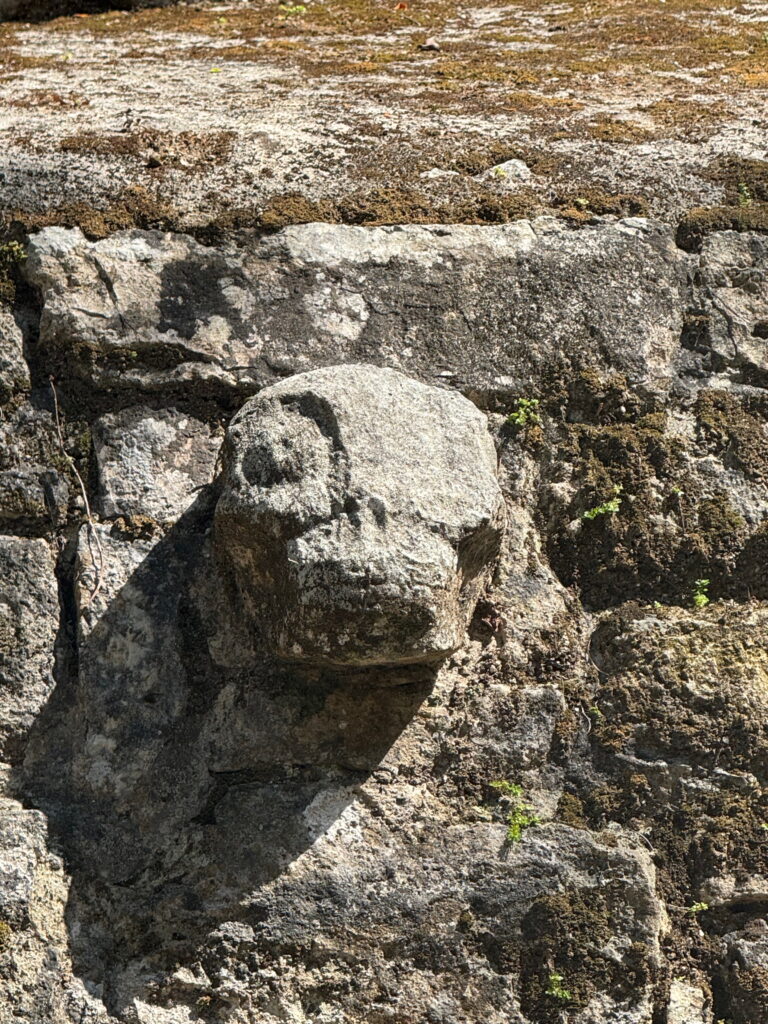
So it was that the lords of Xibalba, One Death and Seven Death, heard the ruckus and said: ‘What’s happening up there on the surface of the earth? All that stomping and shouting? It is time to summon them to come play ball down here, so that we might defeat them.’
This line comes from the Popol Vuh, the foundational creation myth of the Mayan civilization. Long story short: the twin human brothers Hun Hunahpu and Vucub Hunahpu are in fact summoned by the lords of the Mayan underworld and put through horrific tests and trials. These include a river filled with scorpions, a river filled with blood, and a river filled with pus. Once past these nasty waterways, visitors the boys are challenged to survive the homes of possibly the least desirable neighborhood imaginable: Dark House, Cold House, Rattling House, Jaguar House, Bat House, Razor House, and Hot House. Xibalba also had a ball court. Which is a nice touch.
Hun Hunahpu and Vucub Hunaphu make it through these trials, but they are murdered anyway. Hun Hunahpu’s decapitated head is put in a calabash tree. Still able to speak, the head spits on a passing woman, Blood Moon, daughter of the demon Blood Gatherer, impregnating her. She comes to the surface of the world and gives birth to twins as well — Hunahpu and Xbalanque — who, when grown, descend to Xibalba to avenge their father and uncle, defeating the lords of the underworld in a Mayan ballgame, ironically the same game whose ruckus caught the attention of the demons in the first place. Hunaphu and Xbalanque are transformed into the moon and the sun. Thus begins the Mayan cosmogony. Lotta body fluids, lotta houses out of a Saw movie.
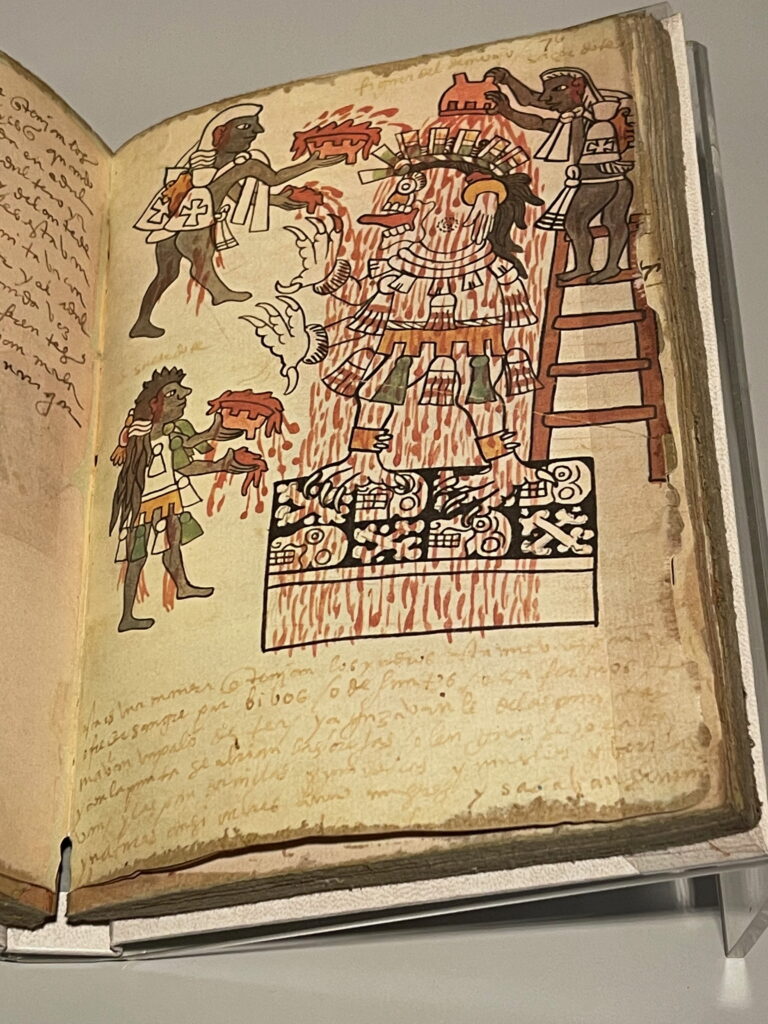
As with so many ancient belief systems, bloodletting was central to rituals surrounding legitimization of rule and cultural order. Metallurgy itself came very late to Mayan civilization, so blood was drawn using implements made of obsidian, stingray spines, or shark’s teeth. In elaborate public rituals atop pyramids the ruling elite would pierce their tongues, buttocks, and penises. The spilling blood was collected and then burned as an offering to the gods. Often this act was accompanied by ritual sacrifice, actual murder, the ultimate offering to the gods. Victims here were almost always high-status prisoners of war. The methods of their deaths, gruesome to most modern sensibilities, were tied tightly to worldmaking legends.
For example in decapitation — the “highest” form of sacrifice — the twins’ stories from the Popol Vuh would be echoed, which is why decapitations were often accompanied by a ballgame. Removal of a still-beating heart by pulling it straight out of a victim’s chest, the most common sacrifice, made absolutely clear the centrality of blood to Mesoamerican beliefs about rebirth. After smearing himself with the blood of the removed heart the priest-turned-cardiac-surgeon would shove the fresh corpse down the pyramid steps where its skin would be removed and worn as part of a dance of new life. If the victim were especially notable his innards would be portioned out and eaten.
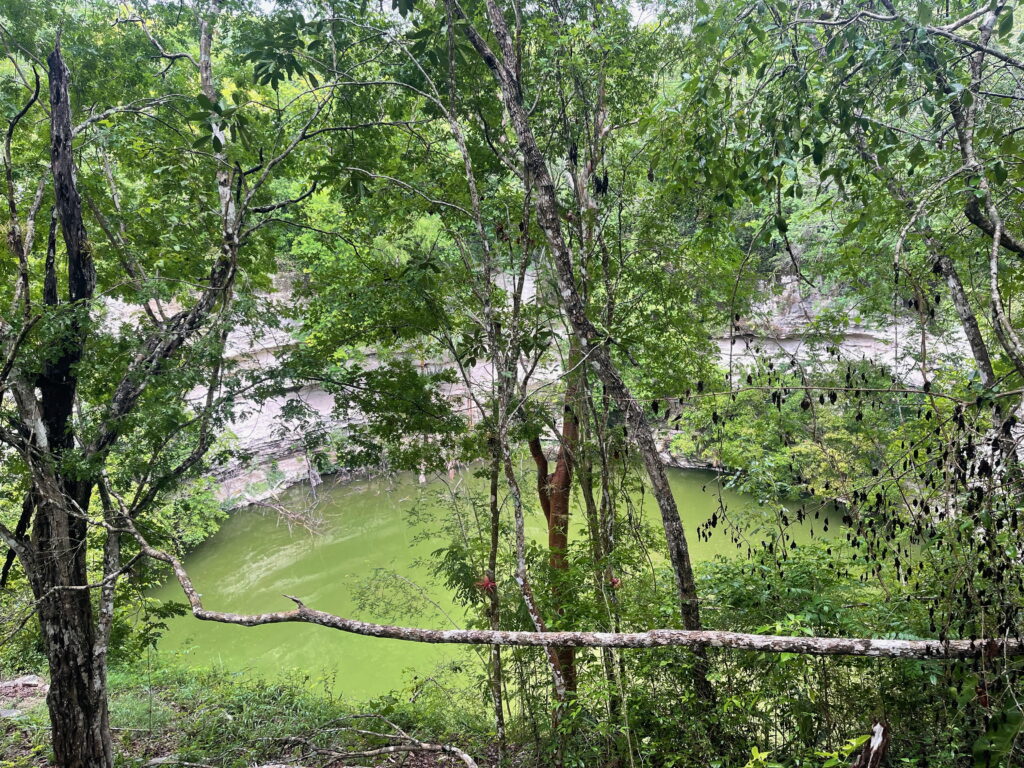
Often sacrifice was less bloody, if no less impactful. At Chichén Itzá in the Yucatán, during times of drought sacrificial victims were often tossed into the Sacred Cenote, a freshwater sinkhole, whose sheer sides meant no escape. This has been confirmed by the hundreds of skeletons excavated at the bottom of the cenote. There was also live entombment, immolation, cannibalism and, perhaps the ultimate literalization of their creation myth, binding a victim into a tight ball for ritual reenactment of the Twins’ ballgame.
In recent history the Mayans in particular have been associated with the end of the world (subject of a previous installment of The Terror Tourist). This supposed apocalypse was due to arrive on December 21, 2012 and was commemorated among other places in Roland Emmerich’s over-the-top cataclysm porn 2012. But the connection to the Mayan calendar was based on a misunderstanding. Mayan calendrics is incredibly complicated; dates are derived from two interlocking counting schemes, one linear and one cyclical, called the Long Count and the Calendar Round. The Long Count itself was divided into ages of 13 b’ak’tuns, roughly 5,125 years long. Historians backdating to a known zero date for our current age yielded the end of the 13th b’ak’tun as December 21, 2012. Thing is, the Mayans never said the world would end on this date, merely restart in a new age. Indeed almost everything about Mayan calendrics is historical rather than prophetic. They lived in the now. But hey, it was 2012 and we were twelve years overdue for a baseless global end-of-the-world panic.
The real horror of Mesoamerica, alas, was not penis-slicing or skin-wearing or even were-jaguars. (Were-jaguars, yeah!) It was the destruction of these venerable ancient cultures by European colonizers. Starting in the early 16th century, continuing to the capture of the Aztec capital in 1519 and through to the fall of the last independent Mayan kingdom in 1697, this conquest was as much a result of war waged by the Spaniards as by the diseases they brought with them, for which indigenous peoples of the Americas had no immunity. Worse still, we have inherited comparatively little written record of these very literate societies due to the systematic destruction of their records by Christian missionaries. Only four Mayan codexes survived the Spanish flames. True Mesoamerican horror.

This relative lack of material — and the fact that Mayan hieroglyphs were not effectively decoded until the 1970s — didn’t stop Hollywood, though! In fact, it may have helped movie scriptwriters eager to fill the void of received knowledge. Can’t read the glyphs carved on that pyramid? No problem, we’ll just make something up! Let’s go to the movies, travelers.
Right at the outset we have to admit that almost all of the films noted here are prime examples of Mexploitation. Low-budget, sensational, sometimes overtly racist, with a scant if not comical understanding of actual history, these films take bits and pieces of Mesoamerican lore when useful (or more often when in synch with the current desires of the movie-going public). But they sure are fun!
Take for example, The Curse of the Aztec Mummy, maybe from 1957, maybe from 1961. It depends on how you date it and what you consider the actual movie as this has the same cast and storyline as The Aztec Mummy (sorta like Evil Dead and Evil Dead 2). Both films involve a group of scientists searching for an ancient Aztec tomb containing a mummy guarding a mythical breastplate. The mummy of course reanimates, but the real villain here is a scientific rival masquerading Lucha Libre-like known as The Bat. This is a fun watch, especially to see some of the earliest Mesoamerican tropes in film, but beware falling into this hole too deeply. There are multiple films, knock-offs, and re-cuts: The Robot vs. The Aztec Mummy (1958), The Wrestling Women vs. The Aztec Women (1964), Attack of the Mayan Mummy (re-cut of the original Aztec Mummy because, you know, Aztecs, Mayans, all the same).
Q: The Winged Serpent is exceptional monster horror from 1982. Look, if all I told you about this movie is that it involves Quetzalcoatl, the giant winged reptile, nesting inside the latticework spire of New York City’s Chrysler Building, you’d stop this podcast immediately and go watch it, right? This Larry Cohen masterpiece has all of the grit of filming permit-free in 1980’s New York. It follows a street-level crook who accidentally discovers Quetzalcoatl’s nest and then extorts the city for directions to it. You should watch this film. Also, why has no one made a sequel to this? The egg is sitting right there.
Then there’s The Laughing Dead from 1989. You’re gonna have to find this one on your own online (if you know what I mean), though there is a Vinegar Syndrome Blu-Ray available. What I saw, ironically, was a Spanish-captioned rip. Anyhoo, this one is basically incomprehensible, though the plot is basically the same as 70% of Mexploitation films: “A ragtag group of people go on an archaeological trip to Mexico to visit Mayan ruins, but get more than they bargained for, when they encounter a zealous group of Mexicans attempting to revive a deadly ancient ritual of their ancestors.” Students of Mesoamerican history will appreciate the nod to decapitation and ballgames as one victim’s head is sliced straight into a basketball hoop.
The Ruins from 2008 actually has nothing to do with ancient cultures except that it is set on top of a ruined Mayan temple — and even this was not in the original book. This is vegetative horror — basically Alien except for gardening, “The Lonesome Death of Jordy Verrill” from the original Creepshow, except as a hangout movie. It’s actually a fun watch and there are some great deleted scenes and a much darker, alternate ending on YouTube. Have a watch of this one, tourists.
Squeaky actually watched and discussed Maya from 1989 recently. This is basically the same plot as The Laughing Dead with a Texas Chainsaw vibe. At least The Laughing Dead felt Mexican. This one exudes Texas. Like, why are there so many Americans running around? It’s worth a watch though for the final act which involves a Day of the Dead celebration (thoroughly Christian, but whatever) whose goal is to resurrect King Xibalba. Lots of nudity, lots of senseless gross-outs (like a guy vomiting small green snakes). I recommend.
Some optional itineraries for those who’d like to travel further:
- The Old Ways
- The Dead One
- La Llorona (2019 from Guatemala, directed by Jayro Bustamante) — not to be confused with the James Wan’s The Curse of La Llorona or the Danny Trejo The Legend of La Llorona
- Curse of the Mayans
- Curse of the Maya
- México Bárbaro
- Dolly Dearest
The truth is, there are not many exceptional Mesoamerican horror films. It just hasn’t had its day like Egyptian horror. This is in contrast to Mesoamerican horror literature, a truly thriving sub-genre. So, aspiring horror scriptwriters and directors, this material is ready for you. What are you waiting for? Make the sacrifice!
That’s it for today’s journey, my touring pals. Time to relax, maybe avoid ball courts, and put on a good movie. Until next time!
A full list of the movies mentioned above can be found at Letterboxd. Find out where to watch there.
The Terror Tourist is my occasional segment on the Heavy Leather Horror Show, a weekly podcast about all things horror out of Salem, Massachusetts. These segments are also available as an email newsletter. Sign up here, if interested. Here’s the episode containing “Descent to Xibalba”:
No Kings

High resolution printable version available here.
A Trip Down Witch Lane
Prefer to listen to this post?
Good evening, fellow travelers! Dust off those walking shoes or mount your beast of burden because on this journey we’re traveling down a single road. It’s a relatively lengthy one, though, and it has many ups and downs, twists and turns. Today we are taking a trip down Witch Lane.
Like all good excursions this one may say as much about the tour guide as it does the locale. You see, in a few days my wife and I will own a home on a road called Witch Lane located in the Norwalk, Connecticut village of Rowayton. This is not in itself all that novel. There are dozens of place names on the east coast named for witches: Witch Path in West Springfield, MA; Witchtrot Road in South Berwick, ME; Witchduck Road in Virginia Beach, Virginia, Witches’ Rock Road in Bristol, CT, and so on.
It is also, of course, coincidence that I am about to live on Witch Lane and I am a member of the number one horror podcast out of Salem, Massachusetts, a town globally known for its association with accusations of witchcraft. Or is it a coincidence? Let’s explore.
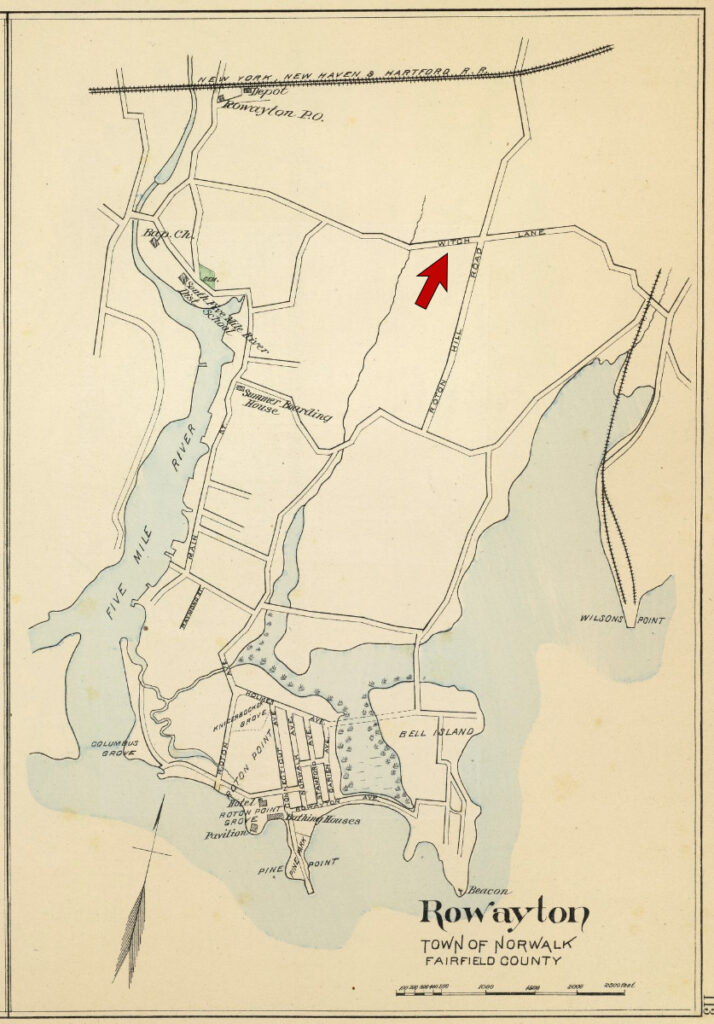
I like to know a bit about the places that I live, so, being a naive new transplant to the region, one of my first educational stops was the local historical society. Run out of one of the oldest and arguably most scenic old homes on the Rowayton waterfront, the historic association is the keeper of archives, photos, artifacts and memorabilia of this coastal community. I knocked on the door and was greeted by a group of older ladies, most of whom were holding brooms. This is not a joke, travelers, for it was spring cleaning day at the historical society. I explained that I was new in town, about to move to Witch Lane, and that I was curious about the place name etymology. (Word nerd sidebar. There is a term for place name etymology: toponymy.)
Surely these ladies would know something about a lane named Witch in a town full of roads and parks named mostly after Native Americans and prominent early settlers. But no. “No one knows,” they said, straight-faced. I could not believe this. And they added that no one seems to know why there’s a small forested area called Devils Garden either. I said “Witch Lane literally becomes Hunt Street a little way down from our house. Can this possibly be unrelated to, you know, witch hunts?” Blank stares from the ladies. As it happened the former town fire marshal was in the building at the time so I asked him too. Nope, nothing, no idea. Now, I understand that not everyone is as interested in the bizarre and the horrific as I am, but shouldn’t a historical society at least have an inkling about a place name like Witch Lane, especially in a state still reckoning with its legacy of witch accusations?
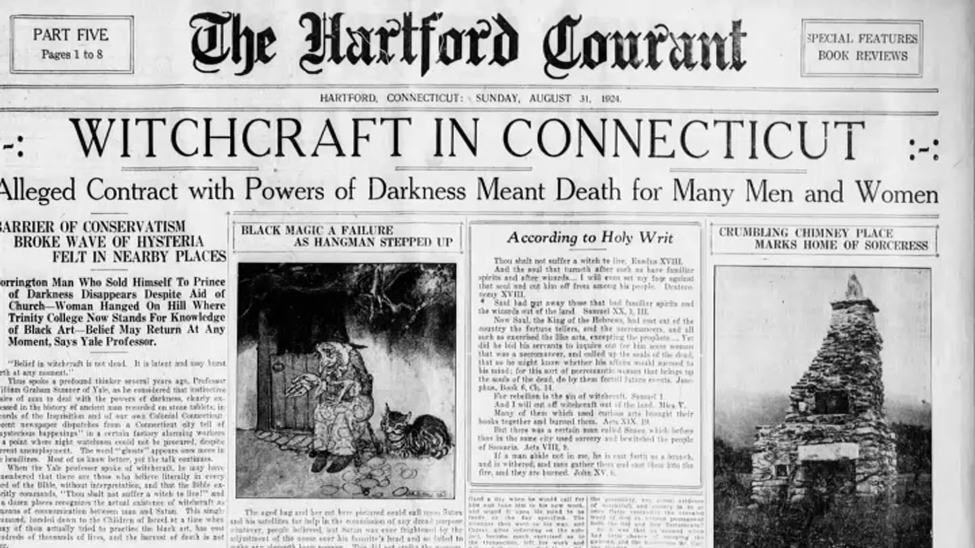
And then I had a thought: maybe feigning ignorance is precisely what a group of broom-wielding ladies (dare I say, a coven) would do. They are entrusted with safeguarding the village lore. Maybe they don’t just willingly give that information to an outsider who comes knocking. Or maybe they knew I would come asking, which is why the fire marshal was there. You see, the home we are about to move into is not the original house on the lot. The former building there burnt to the ground in 2014. I had contacted the current fire marshal to inquire about this and his response was that the cause of the fire was never determined but that it consumed the entire structure and caused no loss of life. The owners, however, did not stay. Could it also be coincidence that the former fire marshal was also in the room when I stopped in? Perhaps they had a plan all along to deal with me, the nosey newcomer.
Now, if this sounds like the plot of one of the many films we’ve reviewed on the Heavy Leather Horror Show you would not be wrong. And this would be the part of the movie — almost a cliche in much of horror — where I take matters into my own hands and fall down a research rabbit hole. Cue the scene where I visit the local library (which I did), images flitting by on a microfilm machine (have not done that yet), and video calls with an elderly professor of the occult (which I will do if I have to). Here’s what I have learned.
Of the six or so books I read on Rowayton only one contained any mention of Witch Lane’s name derivation — and that was in an appendix I almost missed. It notes that Witch Lane is one of the area’s earliest named roads. Indeed, as late as the mid-19th century it is really only one of three roads depicted on the oldest extant map we have of the area. But then the appendix says two interesting things:
Said to be named for some women residents speaking a strange tongue.”
A dozen French speaking Arcadians were billeted in Norwalk during the French and Indian War 1759. Some may have remained and thought to be witches.”
Let’s take these separately as I am not sure they are necessarily related.
The first — “Said to be named for some women residents speaking a strange tongue” — seems plausible. The first witch execution in the colony of Connecticut was in 1647, kicking off a period of hysteria that lasted almost two decades. Norwalk — the larger city to which Rowayton belongs — was founded in 1651, right in the middle of this panic. Most people have of course heard of the Salem witch trials, whether from numerous TV shows and movies, the play The Crucible, or simply from the way it is seeped into everyday language with the term “witch hunt”. But Connecticut’s collective delusion much predates Salem’s and on a percentage basis of accused-to-executed was far deadlier. Accusations of witchcraft in Connecticut flared up continually culminating in the nearby Stamford witch trial in 1692, contemporaneous with the mayhem up in Danvers. Fair to say that a fear of sorcery — or at least fear of people acting oddly — was in the water here. It does not defy belief that people, especially women, speaking a strange tongue would be othered at best, thought to be witches at worst.

There’s a problem with this theory, though. The first settlers in this particular area, what would come to be known as Rowayton, are not known to have arrived until 1740, well after the witch craze had subsided. (The last witch execution here happened in 1697.) And this is where the second sentence possibly offers some insight: “A dozen French speaking Arcadians were billeted in Norwalk during the French and Indian War 1759. Some may have remained and thought to be witches.” Now, there are two possibly sloppy things about this statement. The first is that the author here is clearly referring to Acadians not Arcadians. And the second is the odd verb “billeted”. To explain this let’s take a fork in the road briefly for a quick refresher on colonial American history, my compatriots. The French and Indian War — a conflict between the empires of England and France waged worldwide as the Seven Years’ War — took place on our continent from 1754 to 1763. In so many ways it set the stage for the colonial revolutionary war and independence that followed, but that’s not a discussion for today.

Of note here is something known as the Expulsion of the Acadians or, more eloquently in French, The Grand Dérangement. Starting in 1755 British troops in the Canadian maritime provinces (Nova Scotia, New Brunswick, etc) became worried about the Acadian peoples, ethnically French descendants of the earliest French families to inhabit North America. Acadians had a distinct culture, developed over the century prior via frequent intermarriage and cultural transference with the local Mi’kmaq indigenous peoples. But their language was French and, though officially neutral in the conflict between England and France, they were thought to be a threat and so were expelled en masse from their homeland by the British occupying forces. Early on in the expulsion most were sent to the American colonies. (Later, thousands also landed in the French-speaking region of Louisiana. The Acadiens became the cajuns.) So, yes, there were Acadian refugees scattered all throughout New England. They would have spoken French — indeed a variation on traditional French with distinct phonology, accents, and grammar. Even colonial Americans familiar with the French language would have considered this tongue strange. The dispersal of Acadians happened precisely during the founding of — and potential road-creation within — the new town of Rowayton, where Witch Lane now runs.
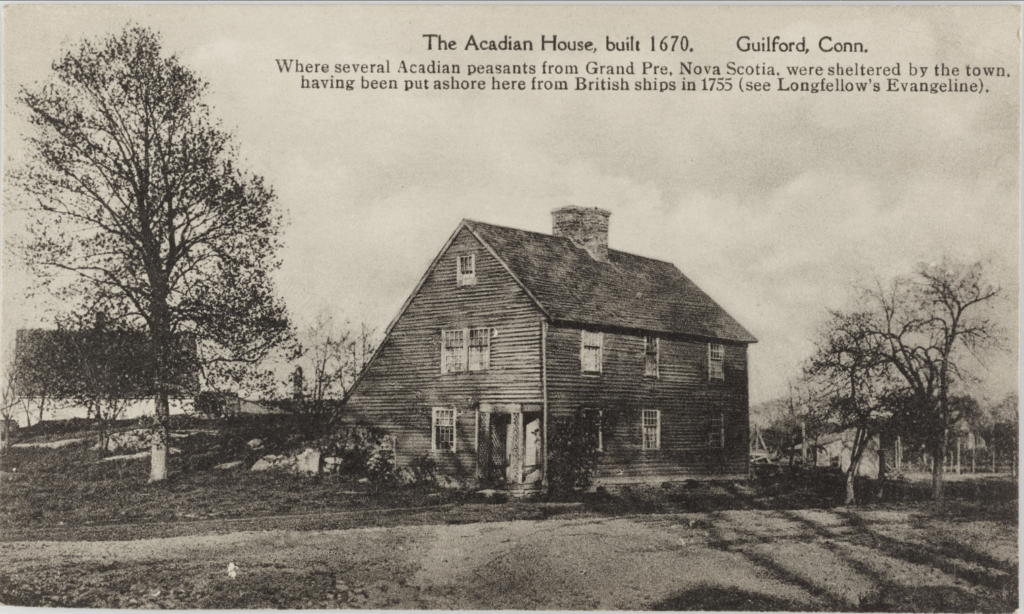
But that word, “billeted”. Typically this refers to soldiers commandeering a civilian house or building. History nerds will recall that the Third Amendment of the US Constitution disallows this explicitly, at least during “time of peace”. But the Constitution uses the more specific term “quartered”, not “billeted”. In either case why would French Acadians kicked out of their homes by the occupying British be considered soldiers at all? Surely they were not fighting for the French. Connecticut was not an active theater at all during the French and Indian War and even if it were everyone there was either British or a British-supporting American colonist. Hardly the place the enemy would “billet”. But there’s another possibility. Maybe they were actually turncoat soldiers who fought for the British and their new home. Yes they were forcibly removed from their land by the British, but maybe — being officially neutral in the first place — they just wanted to fight for their new home. There’s also the possibility that “billet” was just a poor choice of words and that these were mere refugees. Whatever their motivation or political allegiance (and especially as degenerate papists) these were Acadians … and they talked funny. And we all know what funny talk could lead to in god-fearing colonial New England: accusations of witchcraft!
But there’s one last possibility here, as tantalizing as it is less likely. What if the early residents for whom Witch Lane is named were actually practicing witchcraft? What would that even look like? Like other continental forms of folk magic French witchcraft can be traced back through the Middle Ages. People thought to be witches — or who would very rarely self-identify as such — were often healers, cunning folk, midwives, or simply those practicing pre-Christian rituals inherited from their ancestors. French witchcraft is often associated with the grimoire, or book of spells, that witches were thought to carry. The books themselves were real enough, being the first widespread documentation of demonology. (Possibly most well-known is the Petit Albert, a collection of spells and curses for sexual desire, agricultural yield, cooking recipes, and other life hacks.) Often possession of a grimoire was all that was needed to convict someone of heresy and execute them as a witch. Acadians, being originally French, would have brought this European cultural history of witchcraft with them to the New World.
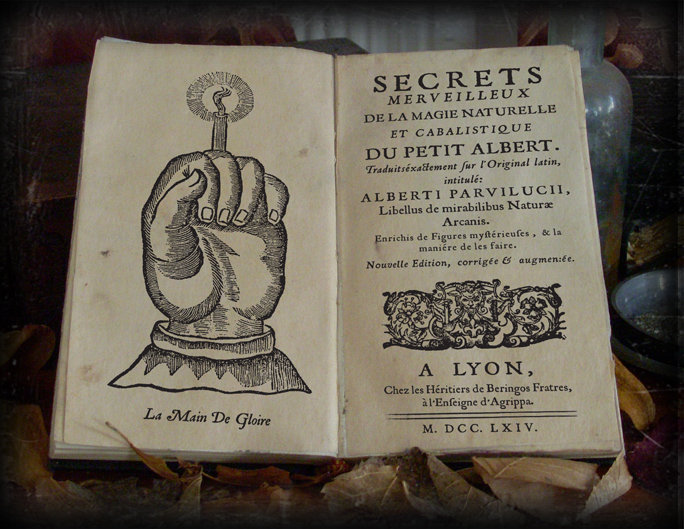
Specifically Acadian witchcraft is not well-studied, but what we do know is that it evolved into a hybrid of European spell-casting traditions and indigenous Mi’kmaq sorcery. The Mi’kmaq, obviously not Christian, revered their shamans for their ability to control the natural world. And the Acadians, being just as prejudicial as other Europeans, would surely have believed these strange-talking others to be capable of witchcraft. Eventually the two traditions merged into a distinctly Acadian set of folk magic beliefs. Is it possible practitioners of Acadian folk magic landed in coastal Connecticut and had a road named after them? Certainly. Is it more likely named for people thought to be evil when in fact they were simply different? Probably.
More importantly, have I, your tour guide and narrator, unwittingly stumbled into a multi-part television series where I am the hapless outsider soon to be sacrificed by the town elders? Will my house be burnt down for my insolence? Or will I instead be welcomed into the local coven of historians? Only time will tell.
There are of course scads of movies about witches set in New England. It’s a cherished American art form. Harder to find are specifically French witch movies (I recommend The Witch from 1906 and Hood Witch from 2023), even fewer Canadian witch movies (I recommend Pyewacket from 2017 and The Curse of Audrey Earnshaw from 2020), and precisely zero Acadian witch movies. (Though there is a children’s novel called The Witch of Acadia. I have not yet read it.) There are a few cajun sorcery movies — I recommend Eve’s Bayou from 1997 — though the degree to which these reflect Acadian beliefs unmixed with voodoo is difficult to disentangle.
But let me at least offer a personal selection of some of my favorite specifically New England-based witch movies, in no particular order:
The City of the Dead (aka Horror Hotel, 1960) — Because Christopher Lee was more versatile than simply starring in vampire movies. Clearly a Salem allegory this one is set in a fictional Massachusetts town in 1692 where a witch named Elizabeth Selwyn is burned at the stake. (Sidenote: no person accused of witchcraft in the United States was ever burnt at the stake. They were all hanged. Witch-burning was an exclusively European thing, and mostly in the medieval period.) Cut to present day and a curious history student takes the advice of her professor (played by Lee) and heads to The Raven’s Inn to learn more about the legends of witchcraft. Guess who’s not really dead? And guess whose side the professor is on. You should watch this movie and you should love it.
Lords of Salem (2012) — Some call this Rob Zombie’s best. I disagree, but it is a good film despite Sheri Moon Zombie being in it. Set in present day Salem, Massachusetts Heidi is a radio DJ who receives a wooden box containing an album by a band called The Lords. She eventually plays it and causes all the women in Salem to enter a trance. This music, you see, was written in the 17th century to control womenfolk. As they say, if it’s nice play it twice.
The VVitch (2015) — Robert Eggers, Anya Taylor-Joy, and Ralph Ineson at their finest. The depressingly hardscrabble rural life depicted in this film influenced my conception of what it must have been like for the early settlers in Rowayton. When the natural world is fully antagonistic it’s easy to understand why the supernatural, for good or for evil, becomes believable. Damn ye, Black Phillip.
The Autopsy of Jane Doe (2016) — One of my favorites, set in the present day, this is the tale of a father-son team of forensic pathologists who must figure out what’s going on with the incorrupt corpse of a 17th century witch. Great use of confined space, a haunted radio, little bells on cadaver toes, and an acting performance that should have won awards from Olwen Kelly who does nothing but lay on the autopsy slab and sheet off spine-chilling vibes.
Mass Hysteria (2019) — Of course there’s a horror comedy based on modern day Salem witch trial cosplay. Is that any more ridiculous than accepting “spectral evidence” — just made-up tales of ghosts — as legally-admissible evidence in the original witch trials? No and it is a lot funnier. This is a short film which overcomes its low budget. Absolutely worth it for the New England witch film completist.
Hellbender (2021) — Technically this is set in upstate New York. (You may argue about whether that is New England elsewhere.) This, though, may be the Adams Family’s best work. It’s certainly their most self-contained in that it was the foursome’s family quarantine project during Covid. Obviously a tale of witchcraft, but more than that it’s about overprotective parenting and why sometimes teenage rebellion has dark consequences.
Well that about does it on our trip down Witch Lane. Obviously witchery is a deep vein to mine, so perhaps we will return to it on a different itinerary. Or maybe this is the last from The Terror Tourist, as the next time this segment comes around I will be a resident of said Witch Lane. And who knows what that will bring? Until then or until never again, I remain, your faithful tour guide.
A full list of the movies mentioned above can be found at Letterboxd. Find out where to watch there.
The Terror Tourist is my occasional segment on the Heavy Leather Horror Show, a weekly podcast about all things horror out of Salem, Massachusetts. These segments are also available as an email newsletter. Sign up here, if interested. Here’s the episode containing “A Trip Down Witch Lane”:
Birdsong
On a trip to visit my son recently I spotted a number of birds sitting on what I think were power cables strung across the highway. (Perhaps they were looking out for wildfires.)

I was immediately reminded of a musical stave, with the resting birds as notes. So I played them. Here’s what they sound like (as ⅛ ♪).
It was a bit of a challenge determining where a “note” fell in the photo, but my rule was if any of the bird visibly descended below a wire it counted as being a note bisected by the line. If not, it was a note between lines. I didn’t put bar lines in or really attempt slurs or much beyond quantization and legato.

I’m not the first to do this. Brazilian musician Jarbas Agnelli beat me to the idea in 2009.
There’s nothing natural or inherent about modern staff notation of course — or of any of the many alternate ways of transcribing music. But the relationship between tones is mathematical and thus spatial arrangement takes on mathematical meaning when music becomings symbolic. Great composers design this spatial arrangement like master architects. Many can write music ex nihilo without first playing it, creating music purely as ink blots on and between lines.
Why are those birds grouped the way they are? Is it completely arbitrary? Are the two birds at far left engaged in something? Is the one at far right outcast? Why do the numbers of birds decrease as the wires get lower? I have no idea, but I do think there is meaning in their arrangement.
The recording above is sonorous, at least, if not exactly catchy. I derive no avian insight from their placement in sonified form. Maybe there’s order there, mathematical or even natural.
I’m going to keep listening.
Unfriendly Confines
Prefer to listen to this post?
You’re in a box. It’s dark. There’s only one thing to focus on. You really can’t make noise. Are you in a coffin or are you in a movie theater?
Greetings, travelers! And welcome to the first itinerary where we really don’t go anywhere. Or rather, the places we’ll visit just aren’t very spacious. It’ll be hard to move around much at all, so take a load off and try to relax as we explore a segment called Unfriendly Confines.
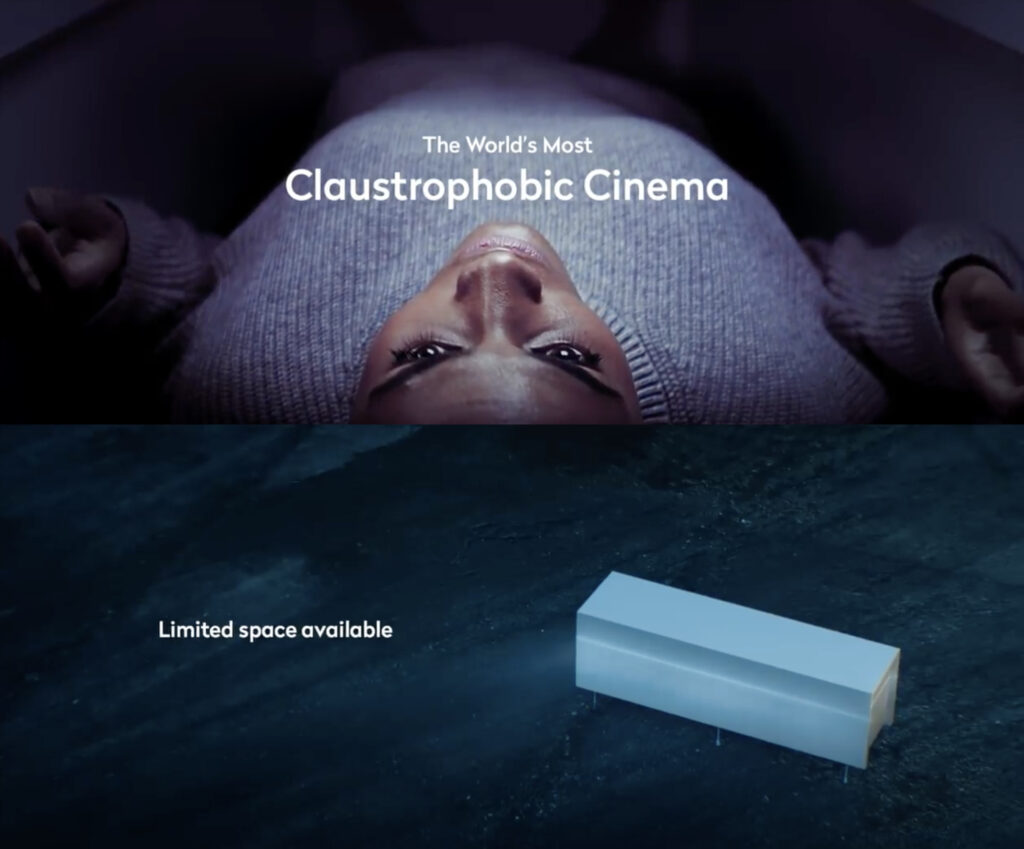
The earliest motion pictures were stage plays performed in front of a camera. How could it have been otherwise? The only directors around then were theatrically trained, so cameras were stationary like the fixed vantage of playhouse audiences. Actors were not yet accustomed to the nuance available when you didn’t have to shout your lines for the cheap seats to hear. The visual language of cinema was still in its infancy.
But we lost something once cinema figured out rapid cuts, unique angles, and sprawling panoramas. Single location films or ”bottle episodes” in TV, as they are respectively known, automatically heighten drama — or at least provide an opportunity for heightened drama — given their intimacy. It’s the same way you lean in to someone when you want to tell them something important … or give them a smooch. Tight quarters are always more dramatic, sometimes in a positive way and often in a very negative way. We of course will focus here on the negative. But before we get to that let’s also consider just the plain economics of single location filmmaking. It’s so much cheaper. Of course we love sprawling epics on the big screen, but a modestly successful film shot in one location — minus the expense of multiple sets, equipment transportation, location producers, etc — almost certainly means your film will make a lot of money.

Most single location movies are thrillers or horror. The reason should be obvious. With very little to look at or to propel the story other than the characters themselves the script (and dialogue) will necessarily be a deep dive into psychological states. Put another way, the space of a single location film is interior rather than exterior. And that can be very very scary, when done well. In the realm specifically of horror, single location films often devolves into claustrophobia. The space itself is a sort of character, providing motivation or challenge or frights simply by being so damn cramped.
Searching for historical beginnings in this micro-sub-genre is complicated by the limited spatial scope of all early silent films. Still The Cat and the Canary from 1927 is generally considered a starting point — and not just of tightly-constrained horror but of the entire “old dark house” setting that characterized so many Universal films through the 1950s. This film — originally a stage play, unsurprisingly — pulls a bunch of family members to a decrepit old house for the reading of a will which leaves all of the decedent’s estate to his most distant relative providing she can be proven sane after spending a night in the mansion. If not, there’s a second will to be opened denoting a different heir. Hijinks ensue (this is, in part, a comedy-horror) and an escaped asylum patient called “The Cat” enters the picture. It’s a fun watch, especially to see what later filmmakers built upon when mining for haunted house tropes and motifs. Note especially the hairy, long-nailed hand reaching through the wall at various points. The Cat and the Canary basically started the we’re-all-stuck-in-a-spooky-house-tonight theme and it’s still going. There’s a straight if dotted line from this film to 2019’s Ready or Not, also about a woman who must survive the night with family in a kooky mansion.
So let’s look at some confined space movies, going from roomiest to most cloying, like a slow-moving trash compactor.
Let’s start in a grocery store. And you know, it sure is foggy outside. That’s right, it’s The Mist from 2007, Frank Darabont’s re-telling of the classic Stephen King novella. Obviously a supermarket is not all that constrained as far as spaces go — and it is certainly well-provisioned. But the interplay of personality types surrounded by an unknown danger outside the all-glass facade of the building makes it seem a heck of a lot smaller. Interpersonal disagreements about what to do escalate quickly as evidence of the mortal peril the shoppers are in becomes unavoidable. So here’s my First Axiom of Single Location Horror: conflict shrinks space. No matter how roomy your confines, when things go south the drama ratchets up. Think about the last time you were on a subway, everyone minding their own business, and then someone does something causing upset (yelling, unwanted solicitation, vomit, whatever). Drama up, you shrink into yourself. The walls close in a bit.
We’ve left the grocery store, safely somehow, but we’re headed to our car, alone, in a parking garage. This movie is P2 also from 2007, a tale featuring only two people in the garage on Christmas Eve. Angela, just trying to go home for the holidays, and Thomas a security guard who also turns out to be a molesting, murderous psychopath. Some spaces — no matter how roomy — seem cloying. I’d put parking garages, especially at night, high on this list. They are never lit well enough, smell of gasoline, and there are no right angles along the x axis, which is disconcerting to the human brain. There’s a safe space, your car, but you have to find it and that in itself can be a source of anxiety. What makes this film work is how inhuman the space is. Parking garages are car storage; they are not for people. Just raw concrete and stains. So the Second Axiom of Single Location Horror: constraint isn’t only about square footage; it’s also a function of habitability.
Let’s go vertical a bit with Robert Eggers 2019 The Lighthouse. Like P2 this one features only two actual people. It’s a great example of psychological horror bleeding into mythological horror. Much has been noted about the standout performances of Willem Dafoe and Robert Pattinson in this tale of isolation and creeping lunacy. It’s a fantastic movie. You should watch it. You’ll get the sense of claustrophobia on this rock immediately. The point I want to make is that the job of a lighthouse is to demarcate space, but in an odd way. The light beacon is both saying “your boat shouldn’t be here or it’ll wreck” and “your boat is on the right path, good job, here’s your waypoint, keep going for safe harbor”. Put another way, it’s saying “get close, but not too close”. Uncomfortable quarters indeed.
Of note, Eggers shot this film in the unusual aspect ratio of 1.19:1, which is almost a square. Known as the Movietone ratio this was used mostly between 1926 and 1932 as silent films were transitioning to talkies. So in addition to reminding cinema nerds of this early phase of stage play films, or reminding today’s congenitally online hordes of Snapchat and Instagram videos, it’s an incredibly crammed visual space to work inside. Not unlike, say, a lighthouse. The film is also shot in black and white. There are nostalgic reasons for this, of course, but technically black and white film reduces the visual clutter, highlighting shape and pattern with the removal of color. It doesn’t make a space smaller, necessarily, but it makes what’s in the frame stand out with more contrast. Negative space is easier to highlight and bright light, overblown like a Fresnel lens swinging around in front of you, immediately consumes the whole space. All of which to deliver the Third Axiom of Single Location Horror: technical creativity in film can be just as useful in creating close quarters as the physical aspects of the set.
Sometimes the confined space is a literal stand-in for us, the viewers, sitting rapt in the theater. All iterations of voyeurism horror owe a debt to the great Rear Window from 1954 by Alfred Hitchcock. Rear Window is emblematic of and a possible decoder for Hitchcock’s obsession with single location (even single take) filmmaking — see Lifeboat, Rope, Dial M for Murder, and of course the shower scene from Psycho. More than anything Hitchcock here seemed interested in using confinement (literal in this case as James Stewart’s character is wheelchair-bound in his apartment for almost the entirety) to make a comment on the act of viewing and our desires as viewers. Those desires include morbid curiosity and male sexual fantasy. And that right there is a good description of the popularity of at least some genres of horror, like 80s slashers. It also is useful biographically when considering Hitchcock’s rampant misogyny. I love this movie for many reasons, but lately it seems even more relevant as hordes of would-be sleuths sit entranced by their computer or phone screens, Rear Window-like, attempting to solve mysteries of what they think is happening in the outside world. Looking at you, conspiracy theorists. But let’s return. The Fourth Axiom of Single Location Horror: often the constraint imposed by the space permits an extended view outward, revealing frights that would otherwise go unnoticed. Peeping Tom, One Hour Photo, and the somewhat recent The Voyeurs are good examples — though there are dozens of others.
Getting cabin fever yet? Climbing the walls? Maybe just seasonal affective disorder? Let’s quickly run through three very different films all of which showcase the diversity of confined spaces. Say what you will about M. Night Shyamalan, but his story for 2010’s Devil is 80 minutes of tight frights. Devil takes place almost entirely in a stuck elevator with five occupants aboard. One of them, it turns out, is Satan himself. Or herself. The lights continually flicker and usually there’s some new mayhem to deal with when the lights return. The five naturally start accusing one another. As ever with M. Night there’s a twist or at least an unforeseen reveal at the end. It certainly got me.
Then there’s Open Water from 2004 about two scuba divers in the tropics who surface to learn that their dive boat has left without them. That’s pretty much the movie: pure survival horror. The irony here is that the open sea could not be a less constrained space. You can go for miles in any direction (including down). Except of course you can’t because you have to eat, you’ll get cold, and you’ll eventually run out of energy. And oh and let’s not forget stinging jellyfish and hungry sharks. So you’re stranded by biological need rather than anything else. In some ways it’s worse than a broken elevator.
Changing climates we arrive at Frozen — no not that one — the one from 2010 that follows three snowboarding buddies who are stranded on a chairlift when the ski hill operators forget they’re there and shuts down for the weekend. This is also survival horror of course — where the threat is dehydration and freezing to death — but here there’s one, actually two, obvious ways out of the predicament: up to the transport cable or dooooooown to the snowy slopes below. Both are attempted; neither attempt goes well. Also there are wolves for some reason prowling the east coast The tension in all three of these films comes from the breakdown in personal relationships — five people, two people, or three people. Either trust falters, or individual self-preservation takes over, or latent horrible behavior emerges. This is the horror of movies where people are trapped in close quarters. It’s rarely about the threat posited in the trailer or promotional material. And so to our fifth and Final Axiom of Single Location Horror: Human foibles metastasize, usually catastrophically, in confinement.
But we’re not quite done. We have to get even more constrained, the ultimate and final constraint really. Buried from 2010 stars Ryan Reynolds in a coffin. For the whole movie. There are a few other actors, none shown except on a grainy cell phone screen and mostly providing only voice. This, my weary travelers, is the apotheosis of claustrophobia horror. There is not a single shot from outside the coffin. Indeed, there is not a single shot repeated in this film. I’d love to see how it was made, technically. Reynolds here plays an Iraq-based American civilian truck driver who is buried alive in a plot to extract a ransom from the American occupying forces. He is given a Zippo lighter and a Blackberry. We are Reynolds in this film, slowly suffocating both from the diminishing air and eventually from leaking sand. In fact, the sand sluicing into the coffin is almost a literal hour glass. You know time’s up when the coffin fills up. I think it works and perhaps is proof that good storytelling requires only … a good story. No elaborate sets, no hyper-realistic effects, no lore. And maybe that’s a bonus axiom which applies to all film: despite the affordances of modern cinema, ultimately to be successful a film must tell a good story. It’s just that sometimes you have to trap the story in a box in order to realize that.
What’s that? You’re itching to get out? A little stir crazy? May I recommend the following?
- 10 Cloverfield Lane in a doomsday bunker.
- Paranormal Activity in a small house.
- Bug in a motel room.
- 1408 in a hotel room.
- ATM in an enclosed ATM station.
- Panic Room in a home panic room.
- Pontypool in a DJ booth.
- Flightplan and Red Eye both on planes.
- Life on a space station.
- All the train-based horror we discussed on our last journey.
Well that’s it this week. For goodness sake, stretch your legs. Go take a long walk or something. Catch a baseball game. May your confines going forward be nothing but friendly.
A full list of the movies mentioned above can be found at Letterboxd. Find out where to watch there.
The Terror Tourist is my occasional segment on the Heavy Leather Horror Show, a weekly podcast about all things horror out of Salem, Massachusetts. These segments are also available as an email newsletter. Sign up here, if interested. Here’s the episode containing “Unfriendly Confines”:
Hell On Wheels
Prefer to listen to this post?
This week our journey isn’t about where we’re going, my tireless travel companions, it’s how.
I’m a train nerd, not quite what is somewhat derisively called a “foamer” (that is, someone who foams at the mouth at the sight of unique rolling stock) more like a casual trainspotter. My grandfather was an engineer on the Burlington Northern railway which is partially how my line ended up in Chicago. Maybe it’s in my blood. And on the subject of blood and trains, this week we’re talking about rail-based horror in a segment called Hell On Wheels. [play train noise ↓]
There’s a pretty compelling argument that one of the first films ever shown to an audience was horror. Or, at least, horrifying. L’Arrivée d’un train en gare de La Ciotat, a 50 second strip of gelatin emulsion and silver halide captured by the French Lumière brothers in 1896, shows a steam-belching passenger train pulling in to a station. That’s it, but oh the sensation it caused. New to almost everyone in the attendance, this moving image, this picture literally in motion of a giant train engine heading straight at the audience caused fear, panic, and fleeing to the rear of the room. It’s been called the founding myth of cinema. And it may be just that, a myth, in the sense that it may not strictly speaking have happened, but it’s also mythic in that it has become the primordial, uncontaminated, visceral audience reaction that every filmmaker — especially makers of horror — longs to achieve.
Trains were at the center of early innovation in spooky special effects. Just seven years after the Lumière boys’ train short an unknown filmmaker created its inverse, literally. The Ghost Train from 1903 shows a train coming around a curve and past a stationary camera, but the print is of the negative, a truly novel technique at the time. This spectral train is made even creepier by the insertion of a separate film of the sun and clouds, also in negative so looking like the moon, up in the corner. It’s a minute long, plotless like L’Arrivée, but it shows the beginnings of technical innovation in filmmaking for the express purpose of frightening viewers.
Even if we didn’t have these charming strips of turn-of-the-century transportation, it cannot be denied that filmmakers love trains. They add an aspect of dynamism, can travel through multiple settings in a short period of time, and offer a conveniently constrained storytelling and staging space for filmmakers to work with. More than one director has noted that trains are in fact metaphors for movies. In cinema, unlike literature, the viewer is not in control. The audience — at least in a theater — has to sit back and experience it until it reaches its destination. You may recall the opening moments of Lars Von Trier’s Europa where the visual similarity between the image of a train going over tracks (or overhead) and film running through a projector is made absolutely clear.
Trains were made for horror. Locomotives can be frightening simply because they are loud, powerful machines made of unforgiving metal — sometimes accompanied by fire, smoke, and sparks. Even better, there’s a whole type of train that only lives in dark, damp underground tunnels full of high voltage wires and rails and pizza-stealing rats. Trains often drag along all manner of characters readymade for horror films: drifters, bandits, late-night urban revelers, people brought together from very different walks of life. Even just the presence of trains can turn a place dark. The term “Hell On Wheels” was originally used to describe the shanty towns of sin that would pop up along the route of the workers as they laid the trans-continental railroad from Omaha to Sacramento. Violent, full of drunks and ne’er-do-wells, and temporary enough to be basically lawless these towns were ready-made to become ghost towns as soon as the rail line moved westward.
Travelers, it’s time to move into the main hall of the station, look towards the clacking of the departure flipboard, and review our options today. The rail yard is so full of train-based horror films we’re going to have to shunt most to sidings. Our departures here today will merely represent the breadth of destinations available in the sub-genre. All aboard! Let’s deadhead this itinerary.
Early experiments with film and trains notwithstanding, the genre mostly begins with Horror Express (1972). This is sci-fi horror with a similar premise to The Thing From Another World. An anthropologist brings the frozen body of an ancient human-like creature onto the Trans-Siberian Railway. Of course, it thaws and it’s … not pleased. Among those stalked aboard this express are Christopher Lee, Peter Cushing, and Telly Savalas. Horror Express is a must-watch for your itinerary.
Also from 1972 and also starring Sir Christopher — with Donald Pleasance at the height of his career — is Death Line also known as Raw Meat. Turns out, a group of Victorian workers who built the London Underground subway were trapped by a cave-in in 1892 and their descendants still live down there by way of cannibalizing hapless commuters. The movie ends with the sound of the cannibals echoing through the tunnels “Mind the gap!” What’s not to love about that?
Maybe the most important stop on today’s journey is Terror Train (1980) featuring Jamie Lee Curtis in her post-Halloween scream queen bender. The premise is everything you’d want in an 80s slasher. A group of graduating college kids, all of whom participated in a prank-gone-horribly-wrong three years earlier, have a masquerade party on a train trip and are picked off one-by-one by a killer who changes into the costume of each of his latest victims. Look folks, this is the only film David Copperfield ever starred in not as himself. And he gets a sword through the head. Somehow this is pleasing. I have always loved the dynamic between the train staff (all adults) and the passengers (all college kids). Everything about this film works, especially its ending. If you liked Jamie Lee Curtis in a costume party on a train in Trading Places you’re gonna love this. Turns out, there is a sequel called Terror Train 2 made 42 years after the fact, which I have not seen. Travelers, should I get a ticket to ride?
Night Train to Terror (1985), which certainly sounds promising, is an anthology made from three unfinished films shot years earlier. The only thing that makes this a train film is that it is framed by a conversation between God and Satan discussing the fate of passengers on their way to Vegas. These My Dinner With Andre interstitials are accompanied by what can only be described as a pop music video happening on the train at the same time. It was 1985 after all and MTV reigned supreme. God and Satan chatting it up, sure. But everyone knows that passenger service to Vegas ended in 1971. C’mon, people. It is absolutely clear that the segments here were intended for longer run times. There are plot threads that go nowhere, leaving only gore and boobs. Which, maybe that’s your thing. I consider this movie pretty much a train wreck.
What if the movie Hostel but on a train? Well, that’s the premise of Train (2008), three years after Eli Roth’s film. Apparently this was originally intended to be a remake of Terror Train, but it became something utterly different — probably after it saw how much buzz torture porn was getting. The setup is a group of American high school wrestlers on their way to a match in Ukraine who board a train to Odessa. Little do they know that every other passenger on board is a patient awaiting an organ transplant of some kind and the tourists are being harvested for theirs. A jostling train may be fine for torture and dismemberment, but it probably is not great for transplant surgery which is why the third act takes place at the ruins of what looks like a medieval hospital along the route. This is a fun movie, utterly derivative, but suitably gory with a believable final girl played by Thora Birch.
The Midnight Meat Train (2009) is why you really don’t want to take the last train of the night on a line that doesn’t run 24 hours a day. Who knows where that thing ends up? This movie, based on a short story from Clive Barker, stars Bradley Cooper and Leslie Bibb. (Brooke Shields is also in it, for some reason.) Bradley is a photographer trying to solve the case of disappearances in the subway late at night. He eventually discovers that a butcher named Mahogany has been responsible for murdering passengers on the midnight train. And the fact that he is a butcher is important because it isn’t cannibal Victorians living down there, but something far more warped from the mind of Clive Barker. I won’t spoil the ending because I love this film and I hope you do too.
D-Railed (2018) contains so many of my favorite things in a horror movie. It’s set on Halloween. It takes place aboard a train, and it takes place underwater. Mr. Tour Guide, you must be thinking, that’s preposterous! Let me explain. The movie starts with a bunch of folks on one of those candlelight murder mystery outings aboard a train. Then it becomes a heist movie. Then the heist goes wrong and the train crashes into a river and is partially submerged. But see there’s a monster in the water, the bastard child of the Creature from the Black Lagoon and the Marvel symbiote Venom. The hapless passengers eventually make their way out of the sinking train car wherein the film becomes a cabin-in-the-woods slasher . And then in the last of too many acts to follow for an 80 minute movie it becomes a ghost story. However, the kills here are gory and 100% practical. Points for that. Points also for Lance Henriksen’s top-billing paycheck earned for about three minutes of screen time.
Let’s take a special spur line to talk for a moment about Asian train horror. It’s an exceptionally robust sub-sub-genre. My favorite zombie flick of all time has to be Train to Busan (2016) from South Korea. This is a great film, period; it just happens to talk place mostly on a train, in train stations, or in train tunnels. And, unlike many films discussed here, it uses the physical setting — rolling cars on tracks — as part of the plot, not just part of the setting. Like old time westerns where the roof of train cars allows cool chase and showdown vignettes, the actual train to Busan is used creatively and surprisingly. Train to Busan has spawned an animated prequel called Seoul Station, also excellent, and a standalone sequel called Peninsula which I have not seen. Junkrat Train (2021) from China is, well, about a train infested with rats. The more high-minded but no less fun Kisaragi Station (2022) from Japan takes an Internet meme about a fictional, supernatural train station and rolls with it.
When my family and I first moved to Denver we often heard a train whistle in the distance, especially late at night. But here’s the strange thing: there were no rail lines anywhere near where we lived in Denver. We searched for the source of this train whistle for months before eventually giving up and simply saying “well, there goes the ghost train again”. It became oddly comforting. If you like ghost trains too be similarly comforted in knowing that there are at least 19 films (most but not all of which are horror) with this name.
There are loads of horror films that use trains only partially and to great effect — let’s call this intermodal train horror. For example, the final scene of Drag Me to Hell (2009) shows the cursed protagonist, Christine, as she falls onto the tracks ahead of an oncoming train. We’re meant to think that death-by-smooshing is the calamity headed for her, until she realizes in that very moment that her efforts to avoid hell were thwarted — and it comes clawing. Rabid, An American Werewolf in London, Friday the 13th VIII (the one which has 20 minutes in Manhattan), and the original Creep all have great sequences aboard rolling stock.
As noted this review of train-based horror barely makes a dent in the subgenre. Others worth exploring if you have a one-track mind include Beyond The Door III, Snakes on a Train, End of the Line, The Tunnel (reviewed on this show last April), and Ghost Track.
In 2007 I rode a magnetic levitation train called the Transrapid, the world’s first production-grade maglev for transit. It runs from the Shanghai airport to the edge of the city and reaches a maximum speed of 268 MPH. This may be the most scared I have ever been on a train. For one, I was the only passenger in my car, possibly the only passenger on the train. For another, when I worked my way up to the cab at the front of the first car and peered in through the dark glass as we broke 250 MPH, I saw the sole engineer enthusiastically reading a comic book not ever looking at her controls or out the windshield. WTF. But mostly it was the knowledge that a derailment (if that’s the term for magnetic de-coupling) at this speed would never be survivable. Especially so since the entire route is elevated a few stories above grade. A crash of this train would essentially be that of a slow-moving, low-flying airplane. It’s all I could think about. I enjoyed it, I suppose, in the same way that a roller coaster is enjoyable. Might be thrilling, might kill you even without a maniacal killer aboard. Who knows? And maybe that’s why there are so many films in this niche genre: the very thing you’re traveling on is a potential threat.
OK, tourists, it’s the end of the line. Thank you for joining me on our search for the dark at the end of the tunnel. May your movie viewing always find you on the wrong side of the tracks.
A full list of the movies mentioned above can be found at Letterboxd. Find out where to watch there.
The Terror Tourist is my occasional segment on the Heavy Leather Horror Show, a weekly podcast about all things horror out of Salem, Massachusetts. These segments are also available as an email newsletter. Sign up here, if interested. Here’s the episode containing “Hell On Wheels”:


